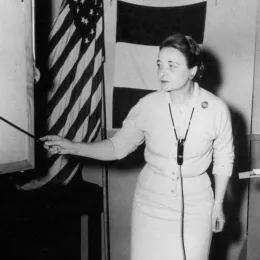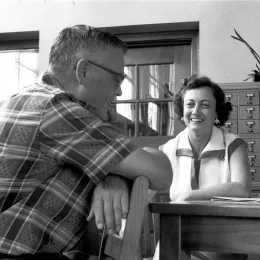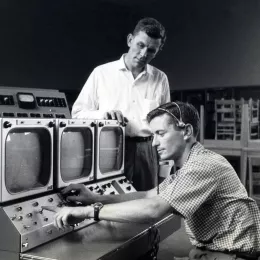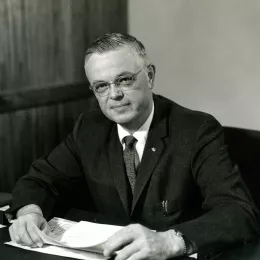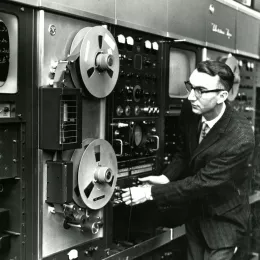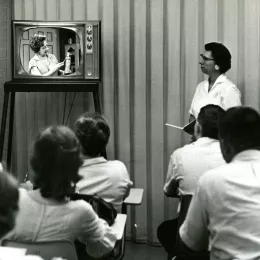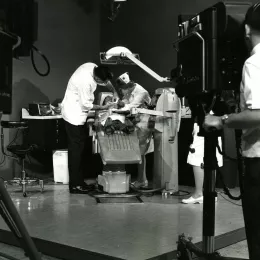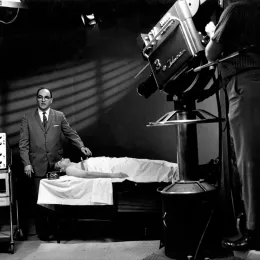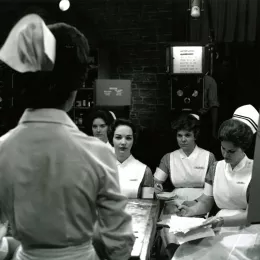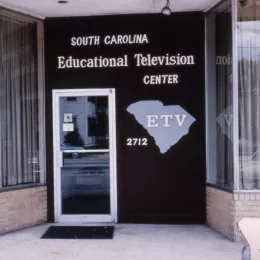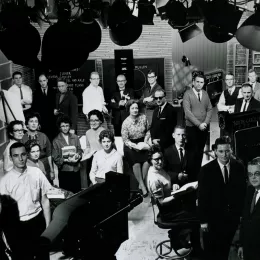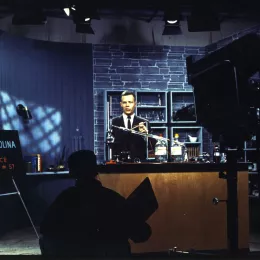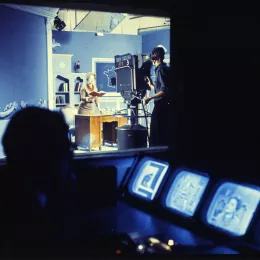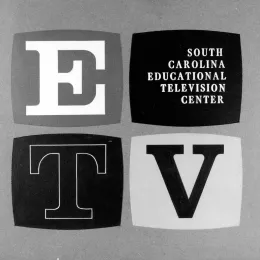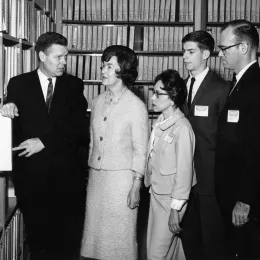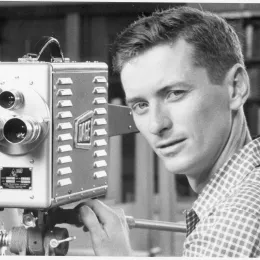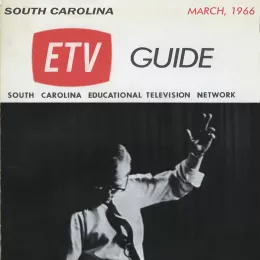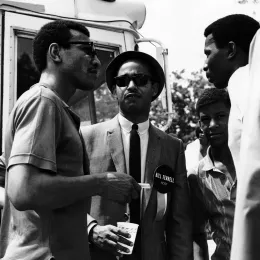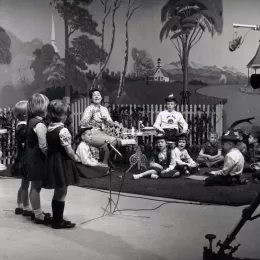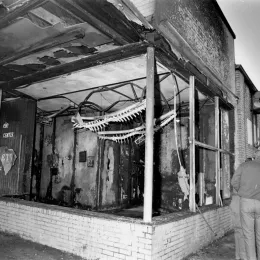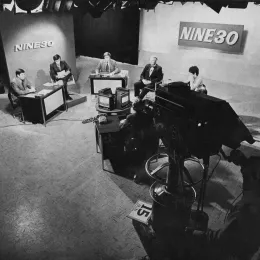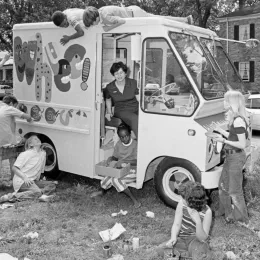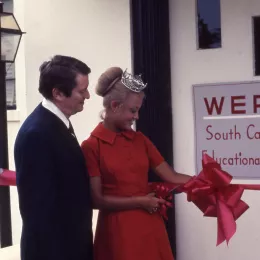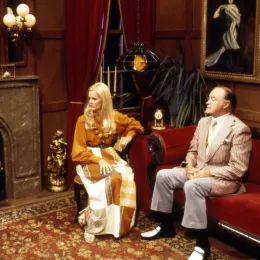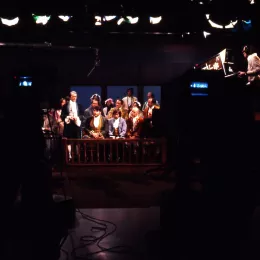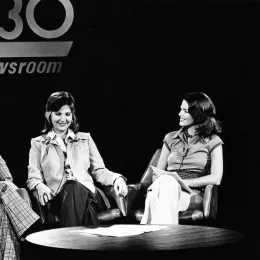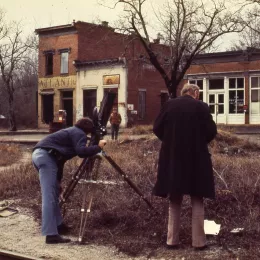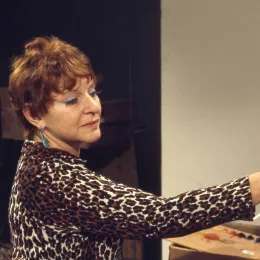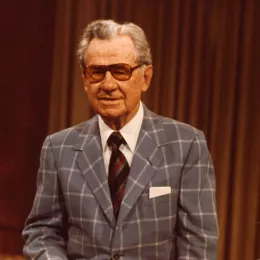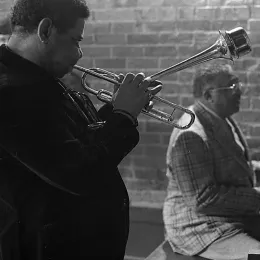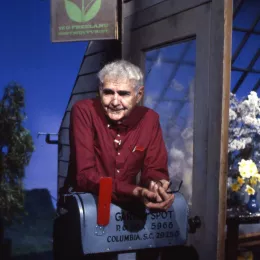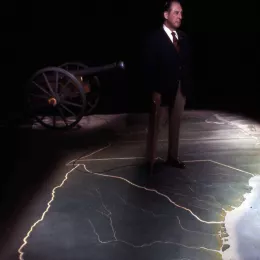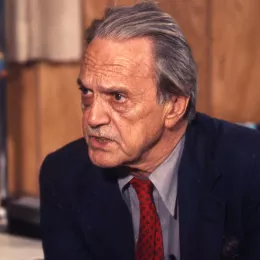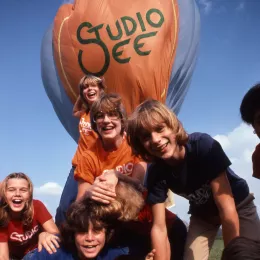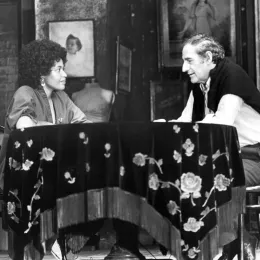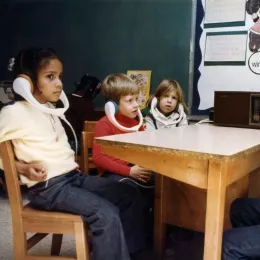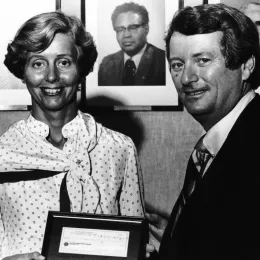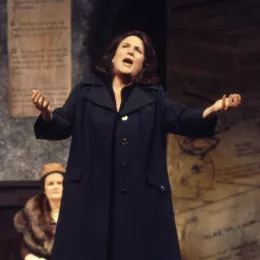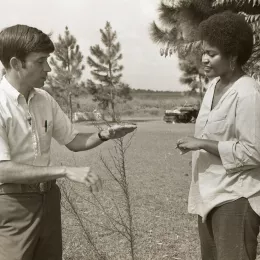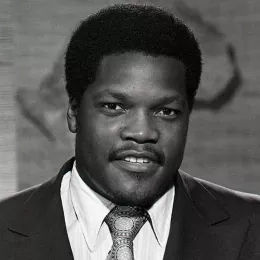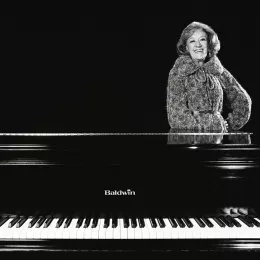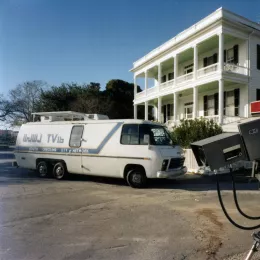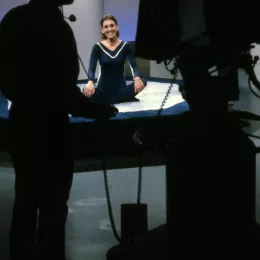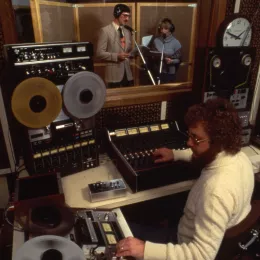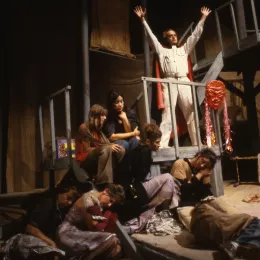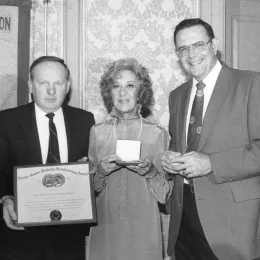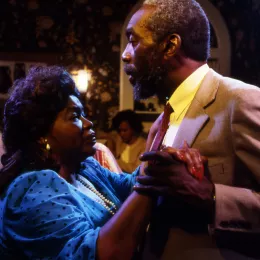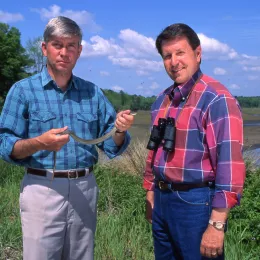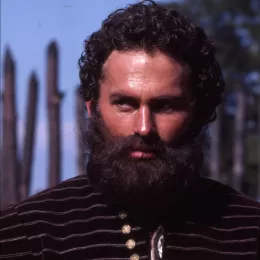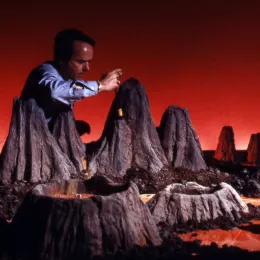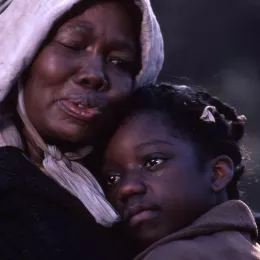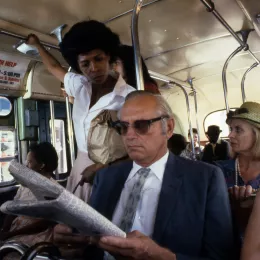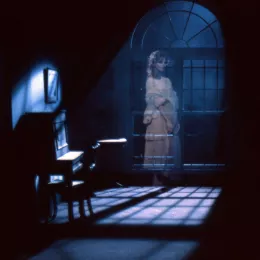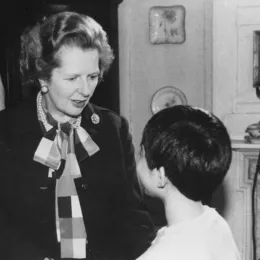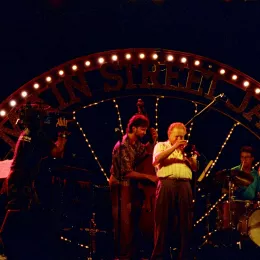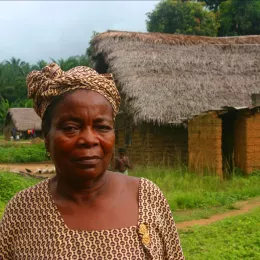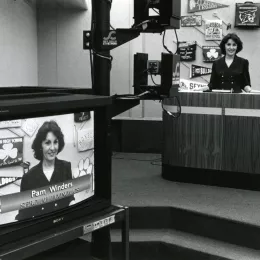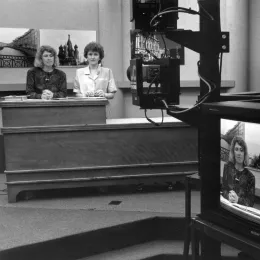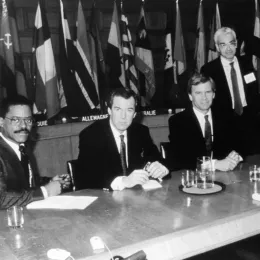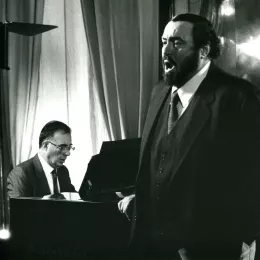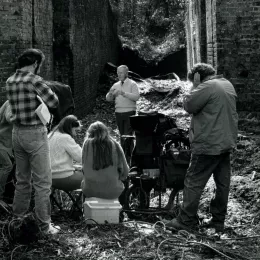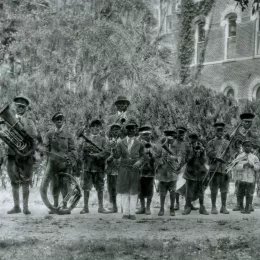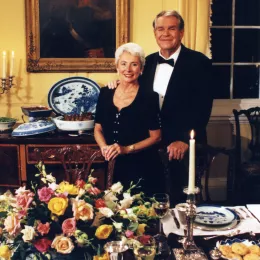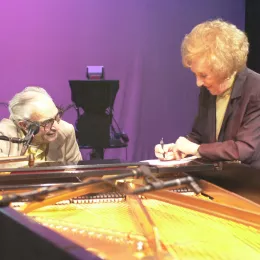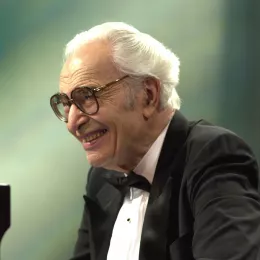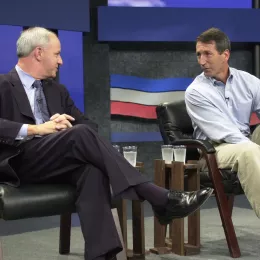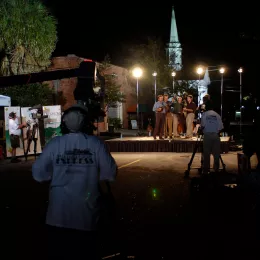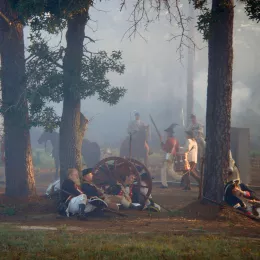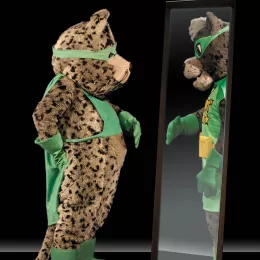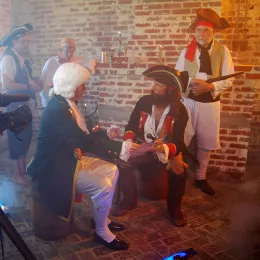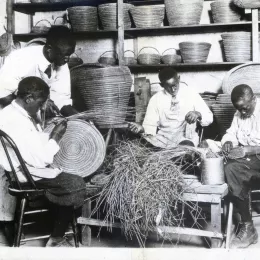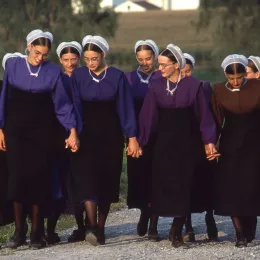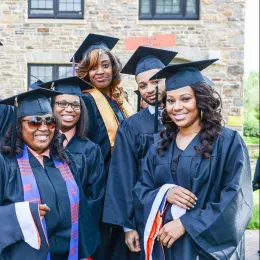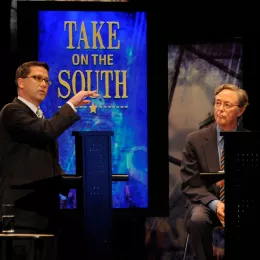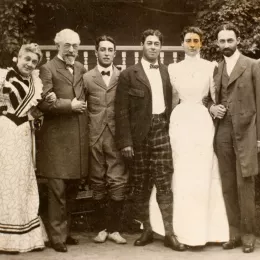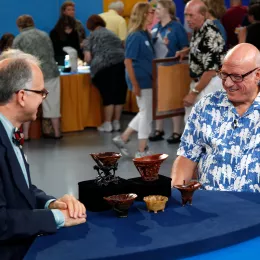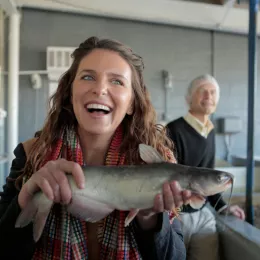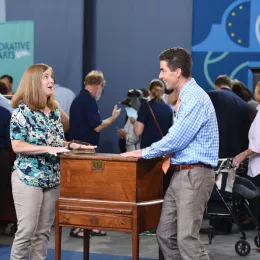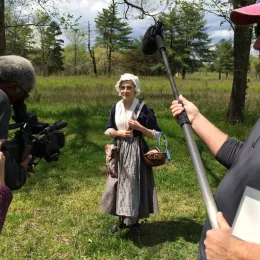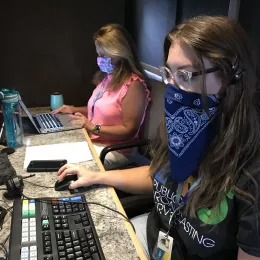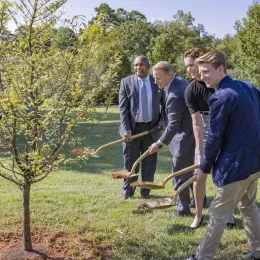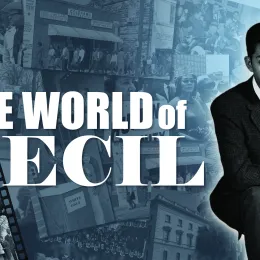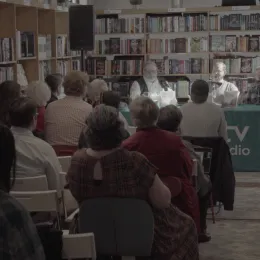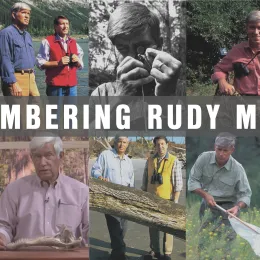1957
In 1957, South Carolina’s General Assembly passes a concurrent resolution calling for a study of the use of television in public schools. The study committee recommends a pilot project be funded.
1958

A studio is built at Dreher High School in Columbia, and the first telecast is transmitted via closed-circuit September 8, 1958. R. Lynn Kalmbach is selected as project director and Henry J. Cauthen is selected as technical director (Both would later serve as president of SCETV). Lucille Turney-High (French) and Cornelia Turnbull (Geometry) are the first teachers and presenters, and 150 students are enrolled in each of the daily classes.
1959
The educational services begin expansion, extending to five Columbia area schools and adding algebra to the curriculum.
1960
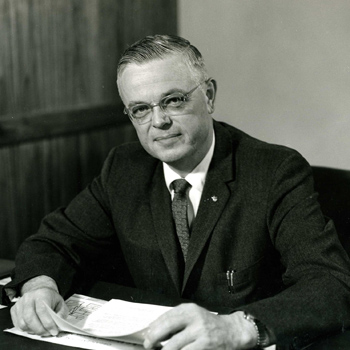
The General Assembly establishes the Educational Television Commission of South Carolina. An empty grocery store at 2712 Millwood Avenue in Columbia, is turned into the ETV studio and broadcast center. The leadership is established with R. Lynn Kalmbach as General Manager, Dr. George E. Bair as Education Director, and Henry J. Cauthen as Director of Production and Engineering. The agency will remain there, expanding into 23+ buildings up and down the street, until 1996. Classes, though still live, are now also recorded using a four-year-old technology called “videotape.”
1961
After its third year of existence, SCETV merges into 31 schools in 11 counties across the state of South Carolina.
1962
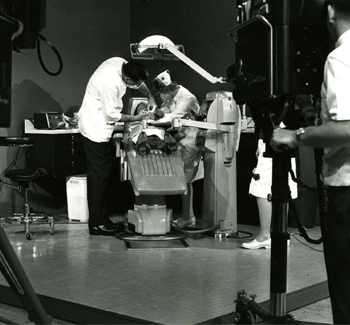
The closed-circuit system expansion allows state agencies and public-school teachers to use SCETV for continuing professional education and post-graduate medical education. The closed-circuit network is extended to all counties, reaching 155 public high schools, 36 elementary schools, most state colleges, university extension centers, and 10 hospitals.
1963
SCETV is now a broadcast entity after signing on with WNTV-TV 29 in Greenville.
1964
The class enrollment climbs to 88,700 at SCETV and an additional station (WITV-TV 7) in Charleston, South Carolina signs on.
1965

Henry J. Cauthen is named Director of Administration and Dr. George Bair is named Director of Education after the death of R. Lynn Kalmbach. Crime to Court, a monthly training video and booklet for judges and law enforcement officers, begins production. It will last for nearly three decades and, at its height, train 6,500 police officers, judges, and magistrates nationally.
1966
An additional station in Columbia, South Carolina (WRLK-TV 35), signs on. The first SCETV program magazine (ETV Guide) is also published, providing the broadcast schedule for NET (National Educational Television) from New York City as well as local productions and classes. Off the Cuff, SCETV's first weekly public affairs program debuts in like manner. Over the years, the weekly, sometimes nightly, program will continue under different titles: 9:30 Newsroom (NINE30) (1971), EIGHT30 (1974), SEVEN30 (1975), Openline (1980), and Carolina Journal (1983-1990).
1967
In a challenging financial year for SCETV, the monthly SCENE Guide publication is temporarily discontinued. The Public Broadcasting Act is signed into law, paving the way for the Corporation for Public Broadcasting, PBS and NPR. Through the setbacks, WJPM in Florence (named for James Pierce Mozingo III) and WEBA in Allendale (named for Edgar Allen Brown) begin broadcasting.
1968
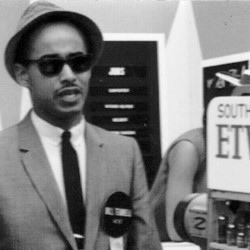
As the agency rises above their previous challenges, the groundbreaking series Job Man Caravan premieres. The new series features popular musical acts while educating minority audiences about career opportunities and job interview techniques. To reach a wide range of constituents, a mobile television unit is used to travel to a different town each week. In addition, a daily program for children, The June Bugg Show, premieres from the SCETV studios. It is hosted by educator June Timmerman and features local children, who are encouraged to be "good June Buggs" by exhibiting good behavior.
1969
After only one year of existence, Job Man Caravan garners SCETV its first Emmy Award. The agency also welcomes the Public Broadcasting Service and the beginning of color broadcasting as they continue to expand. Mister Rogers' Neighborhood is one of the NET programs to move to PBS, with a new program called Sesame Street. Furthermore, the first live domestic satellite transmission in the nation is transmitted from Columbia to Los Angeles as a demonstration during a legislative dinner, making SCETV the "feeder" station for all southern public TV stations.
1960s Gallery
1970

After becoming the feeder station for all southern public television stations, SCETV begins expansion into homes through cable television. New SCETV television courses are also introduced, allowing students to earn their MBA via the University of South Carolina at their local technical college. Additionally, SCETV goes live from Cape Kennedy for Apollo XIII coverage, and Job Man Caravan wins the agency its second Emmy.
1971
To extend SCETV broadcasts to the entire state, the General Assembly approves $3.6 million in bonds, and the agency begins color studio production. SCETV also becomes the presenting station for William F. Buckley's Firing Line, which moves from ABC. In addition, Henry Cauthen is elected to the PBS Board of Directors.
1972
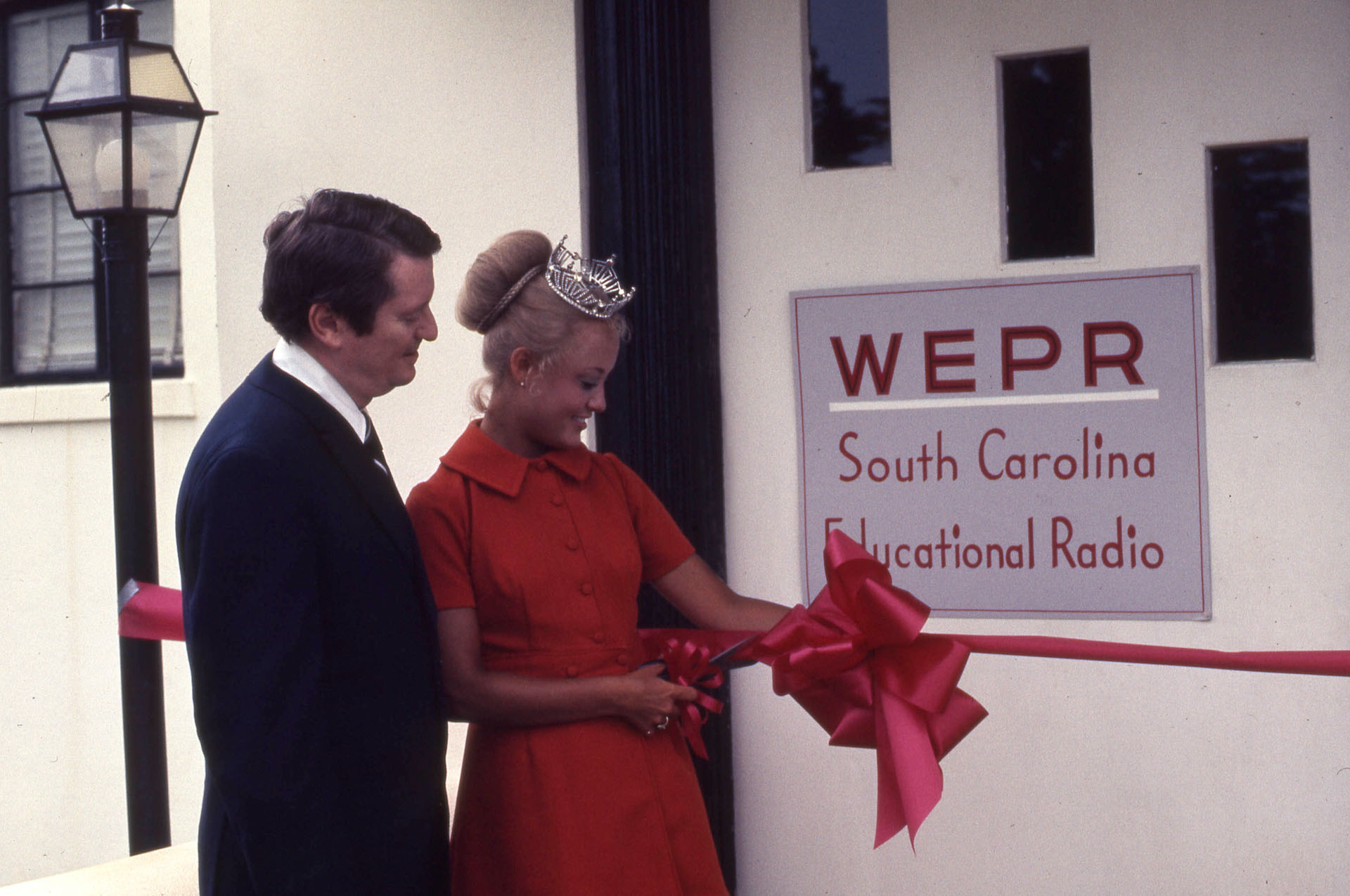
The South Carolina Educational Radio Network (SCERN), which later becomes ETV Radio then SC Public Radio is born. After its birth, WEPR-FM 90.1 in Greenville, South Carolina (via Clemson studios) is the first station to go on the air, broadcasting the NPR Classical News format and airing its first program, All Things Considered. The service includes specialized "radio for the blind" broadcasts, transmitting on a special sub-frequency to those with special radio receivers. The service also includes volunteers reading local newspapers aloud.
1973
After its first year of production, SCERN adds Saturday programming to begin broadcasting seven days a week. The agency conjointly produces, For the People, a new public affairs series for the African-American community with a scholarly bent, with host Beryl Dakers. Saints and Legions, the agency’s first college credit course, by which viewers can earn college credit at home, is launched. Additionally, SCETV airs a documentary on Kenny Rogers, and the first edition of Tell It All, airs nationally.
1974
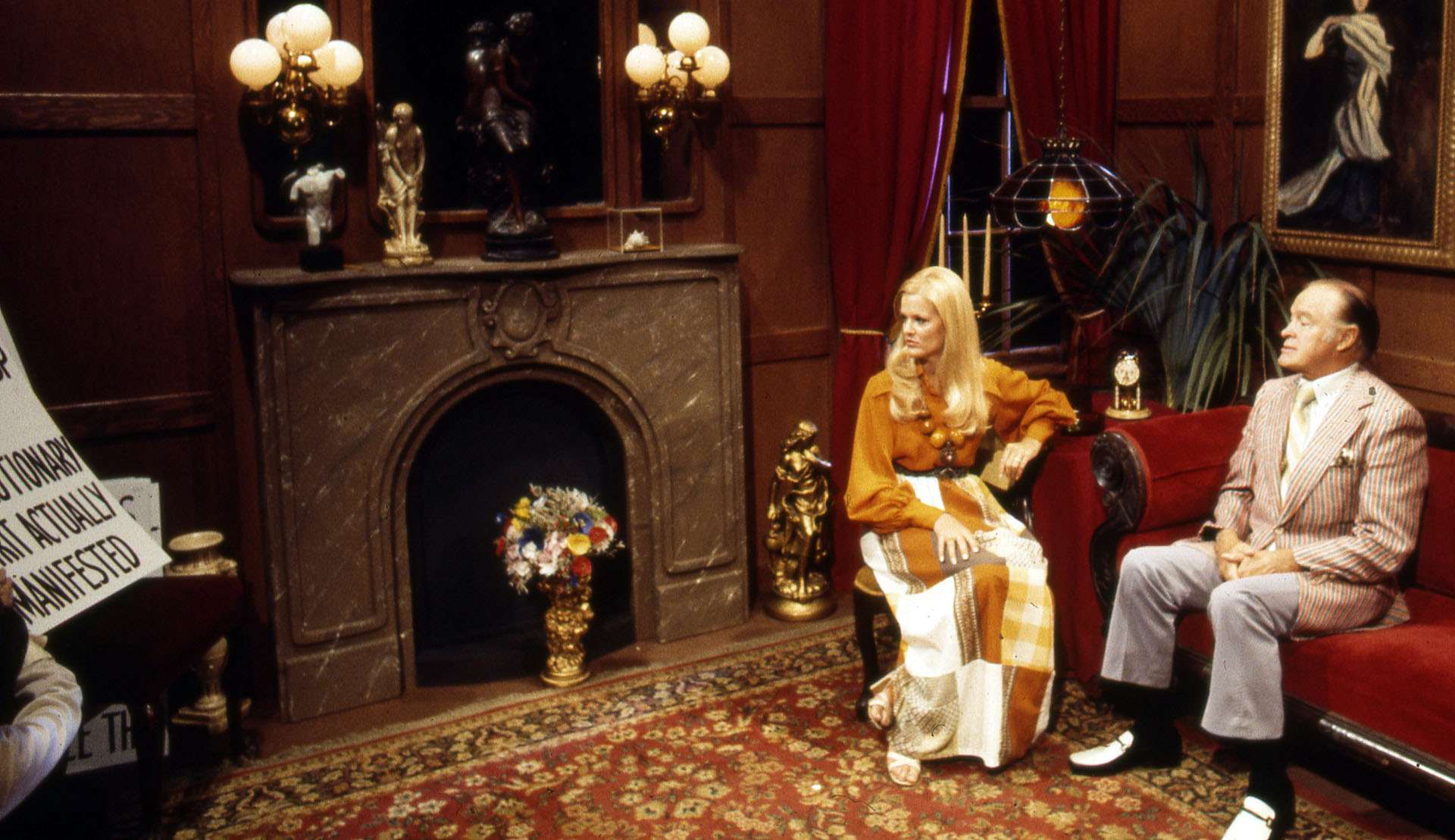
As SCERN expands its reach, WSCI-FM 89.3 in Charleston joins the network. The agency also introduces a new training course for poll workers via television that they can receive at home. The new TV course entitled, The Desk Set successfully graduated 200 secretaries. In addition to the new course, SCETV also produces several programs for television: The Gift of the Magi and a discussion series on race relations hosted by moderator Julian Bond. SCETV also produces Vanishing Towns for the PBS program, Turning Points. The program details entire South Carolina towns emptied and/or relocated to make way for the Savannah River Nuclear Site.
1975
After the Educational Radio for the Blind moves to SCERN's Columbia studios, WRJA in Sumter (TV and radio), and WJWJ (TV) in Beaufort also begin transmitting. Additionally, the agency premieres several projects -- Ilona's Palette, a first-of-its-kind how-to painting program with Ilona Royce-Smithkin, and The Garden Spot, with host Willie Freeland. Additionally, an on-air appearance from Psychic Micki Dahne jams the network’s phone lines. SCETV produces Lowell Thomas Remembers for PBS distribution. The program features the 83-year-old veteran reporter recalling events from 1919 to 1963 using Movietone news footage. The Shadow Catcher, a documentary about photographer Edward Curtis' attempt to preserve Native American culture through photographs, films, and recordings, also premiered.
1976
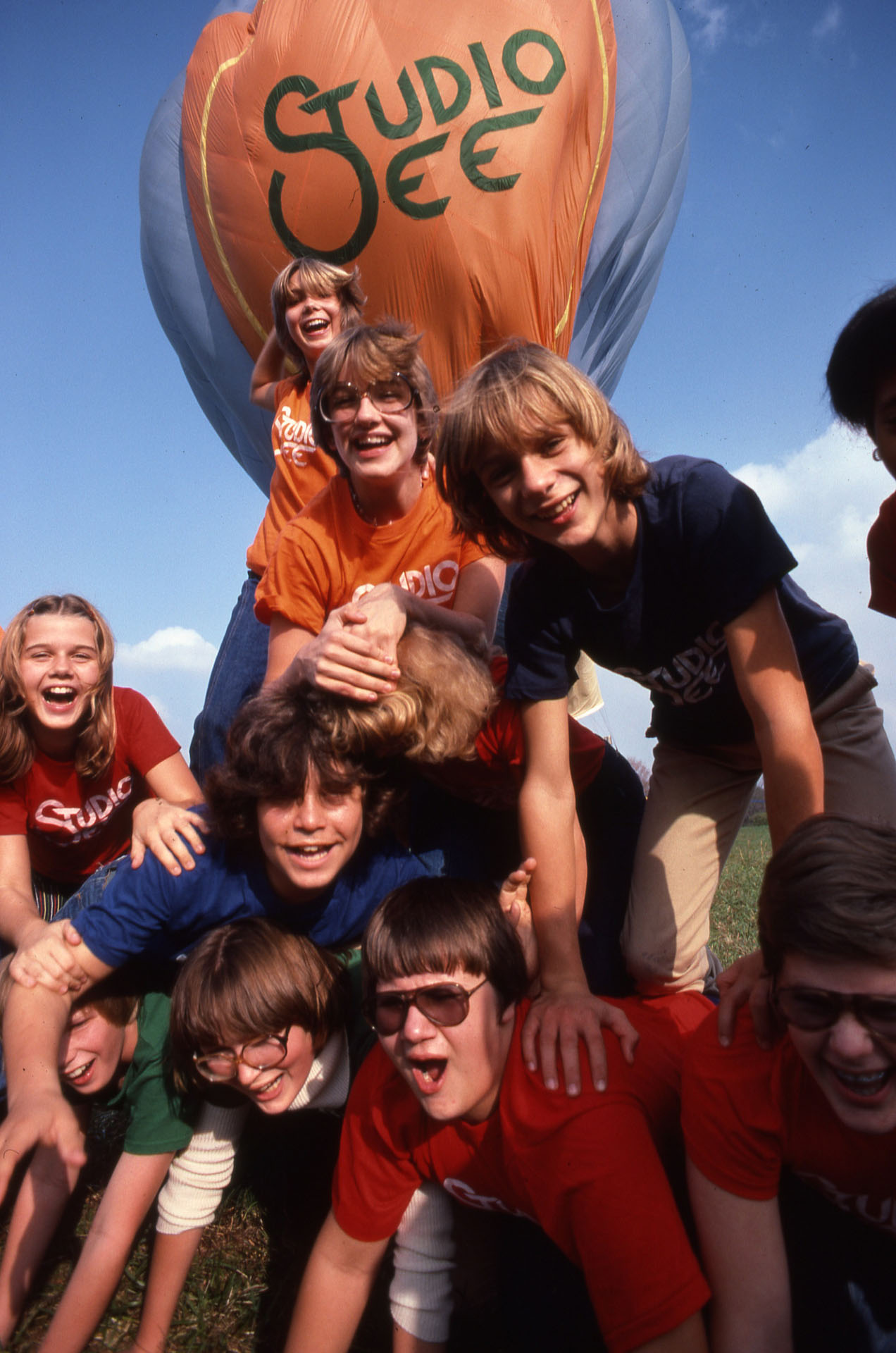
Because of SCETV's tower network, South Carolina becomes the second state in the nation to use NOAA's new weather radio system correspondingly prompting WLTR-FM 91.3 in Columbia to sign in. In conjunction, South Carolina Instructional Radio begins five-day-a-week service with school programming over SCERN. Also on radio, American Popular Song with Alec Wilder and Friends premieres. The agency also debuted a children's program called Studio See, two instructional series: And Then There Were Thirteen with Dr. Henry Lumpkin and Teacher as Manager and the stage production of Sing America Sing with John Raitt, which traces popular American music through history.
1977
To support the educational programs of SCETV and SCERN, the ETV Endowment is created as a non-profit entity with Elaine Freeman serving as the founding executive director. SCERN series American Popular Song with Alec Wilder and Friends wins a Peabody Award. Additionally, SCERN’s documentary about a Charleston student trapped by a cult airs on NPR's Options. The agency uses satellites for the first time to broadcast live continuing education content and medical seminars to Charleston and Columbia. SCETV joins a seven-nation live broadcast, originating the U.S. portion of Christmas Around the World from Columbia Mall.
1978
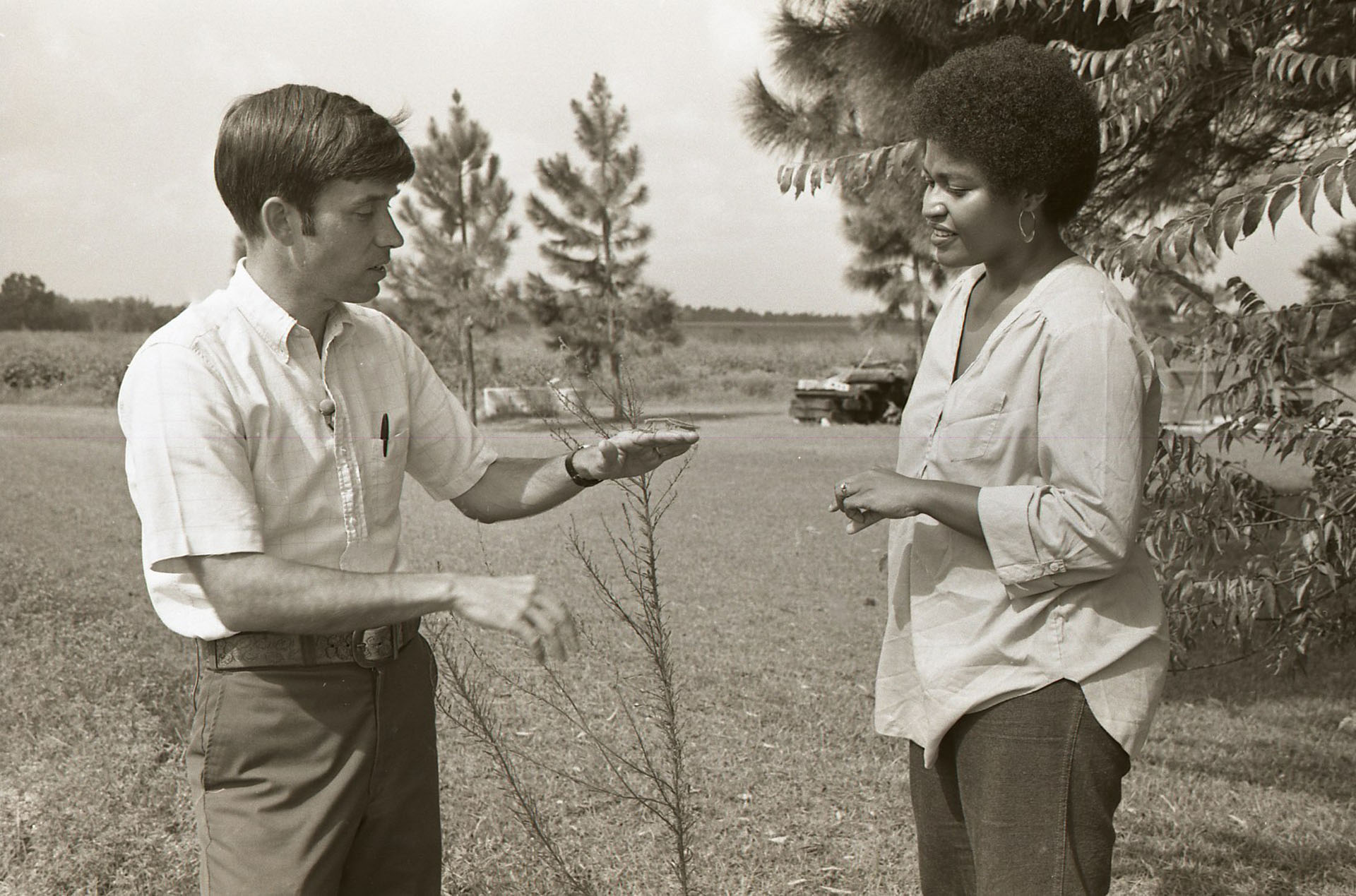
As the radio and television service continues expansion, WNSC in Rock Hill signs on. SCERN's American Popular Song also wins an Ohio State Award, and SCERN presents the 52-week concert series Toscanini on NPR. New SCETV productions include: the debut of NatureScene, Cinematic Eye, a college credit course analyzing 13 European films, and a special episode of Firing Line produced in Columbia, where the host, William F. Buckley is joined by President Ronald Reagan. The agency also joins the PBS satellite system.
1979
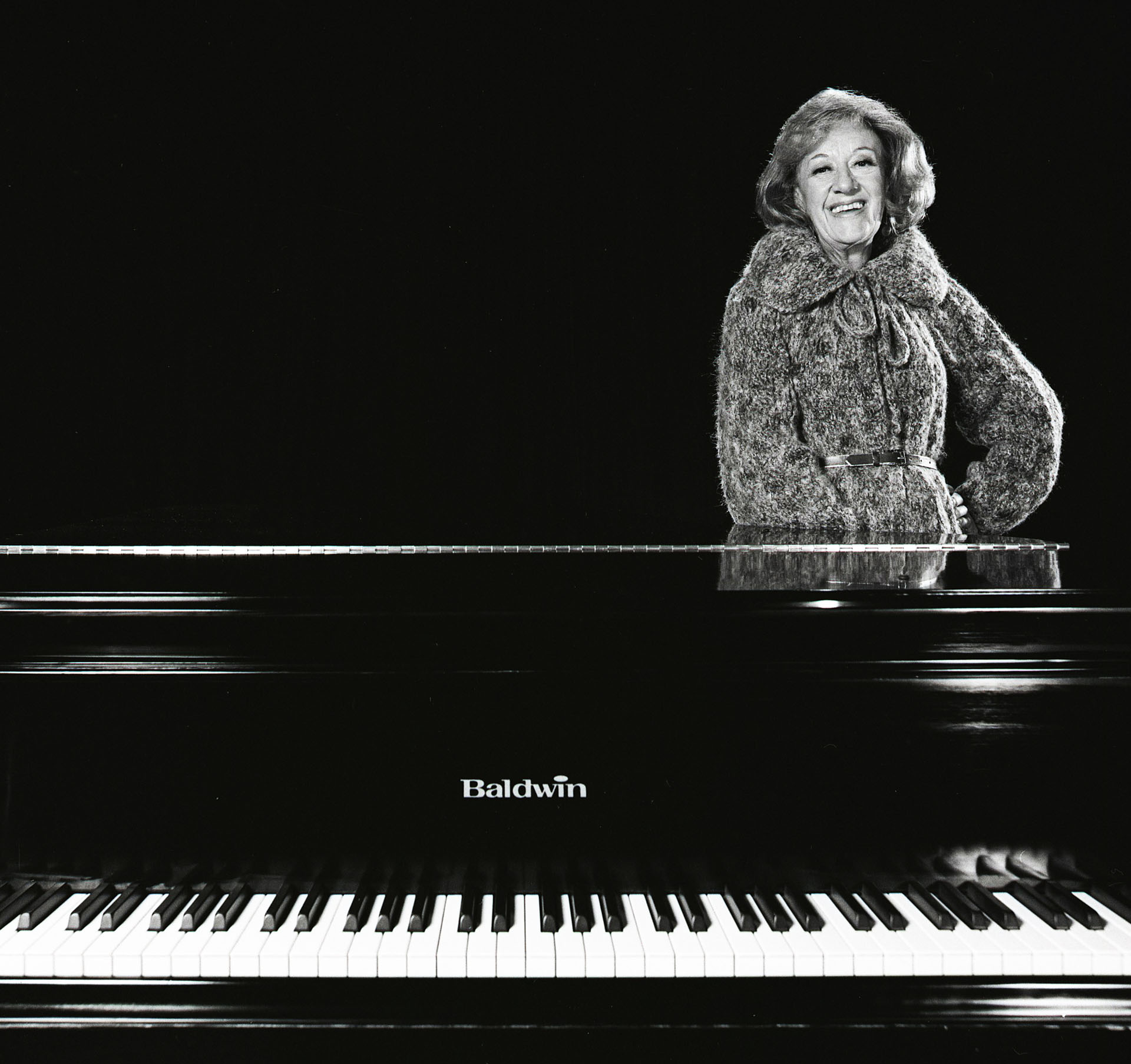
In honor of Hoagy Carmichael at Carnegie Hall, the SCERN tapes a concert and debuts Marian McPartland's Piano Jazz for national broadcast. Additionally, Roots Musik Karamu with host Osei Terry Chandler debuts on one of the SCERN’s station, WSCI-FM. As technology progresses, new ways are being discovered to reach a larger mass. For the first time in the agency’s history, a live performance of Carmina Burana is simulcast. Because TV was not in stereo at that time, the stereo audio is broadcast over the radio network simultaneously. New TV productions include: Feelings, hosted by child psychologist Dr. Lee Salk, The American Short Story, hosted by Henry Fonda, and Ways of the Law, the nation's first legal education series. Cinematic Eye, hosted by Benjamin Dunlap, is also the first telecourse nominated for an Emmy.
1970's Gallery
1980
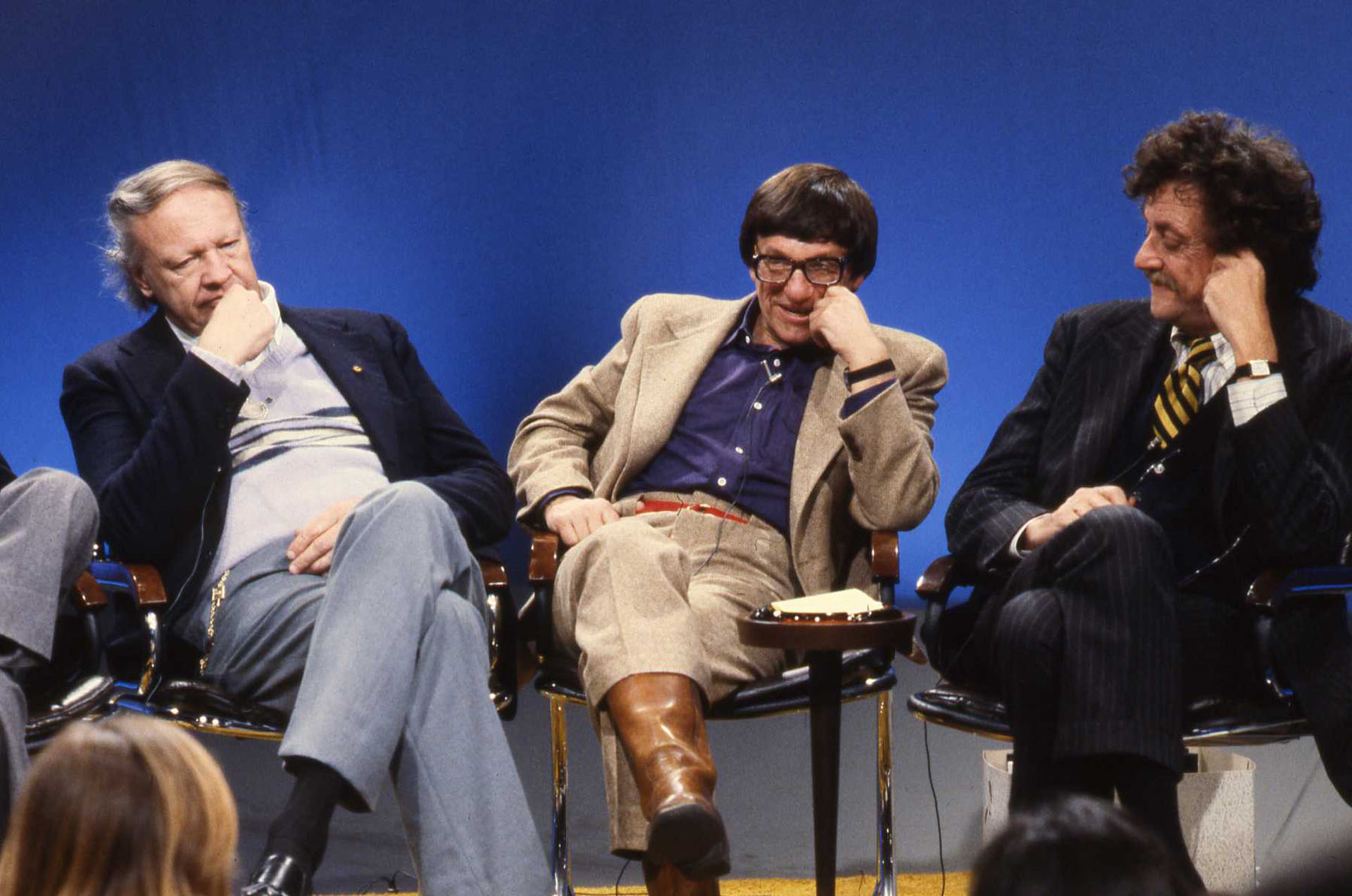
As the list of stations around the state grows, WRTS-TV 49 in Spartanburg signs on (It is later renamed WRET-TV for Rickard E. Tuckey). The college credit course Writer's Workshop, hosted by George Plimpton, debuts with writers and other authors each taping a class session in the SCETV studios. South Carolina Educational Radio Network’s first instructional radio series, Catch On, debuts, as does SCETV's classic series To Life! Yoga with Priscilla Patrick.
1981
As the SCERN series, Chamber Music from Spoleto Festival USA, debuts, WHMC-FM 90.1 in Conway also signs on to the radio network. Additionally, SCETV is selected as the National Center for Instructional Television to transmit programming by satellite to public schools nationwide. The agency is awarded the Verner Award for Government Body.
1982
SCETV joins with KCET Los Angeles, WGBH Boston, and WNET New York to produce American Playhouse, a PBS series designed to spotlight dramatic works by American writers. Along with that, SCERN debuts new series called American Popular Singers on NPR. Red and Mildred, a 1944 CBS radio program featuring Black and white jazz artists together, is re-broadcast nationally.
1983

SCERN presents a series on South Carolina Poets and Appreciation of Jazz, based on a Winthrop college music course for which listeners can receive college credit. Locally, weekly culture series Art's The Thing! debuts with host Beryl Dakers, as does The Bluegrass Sound.
1984
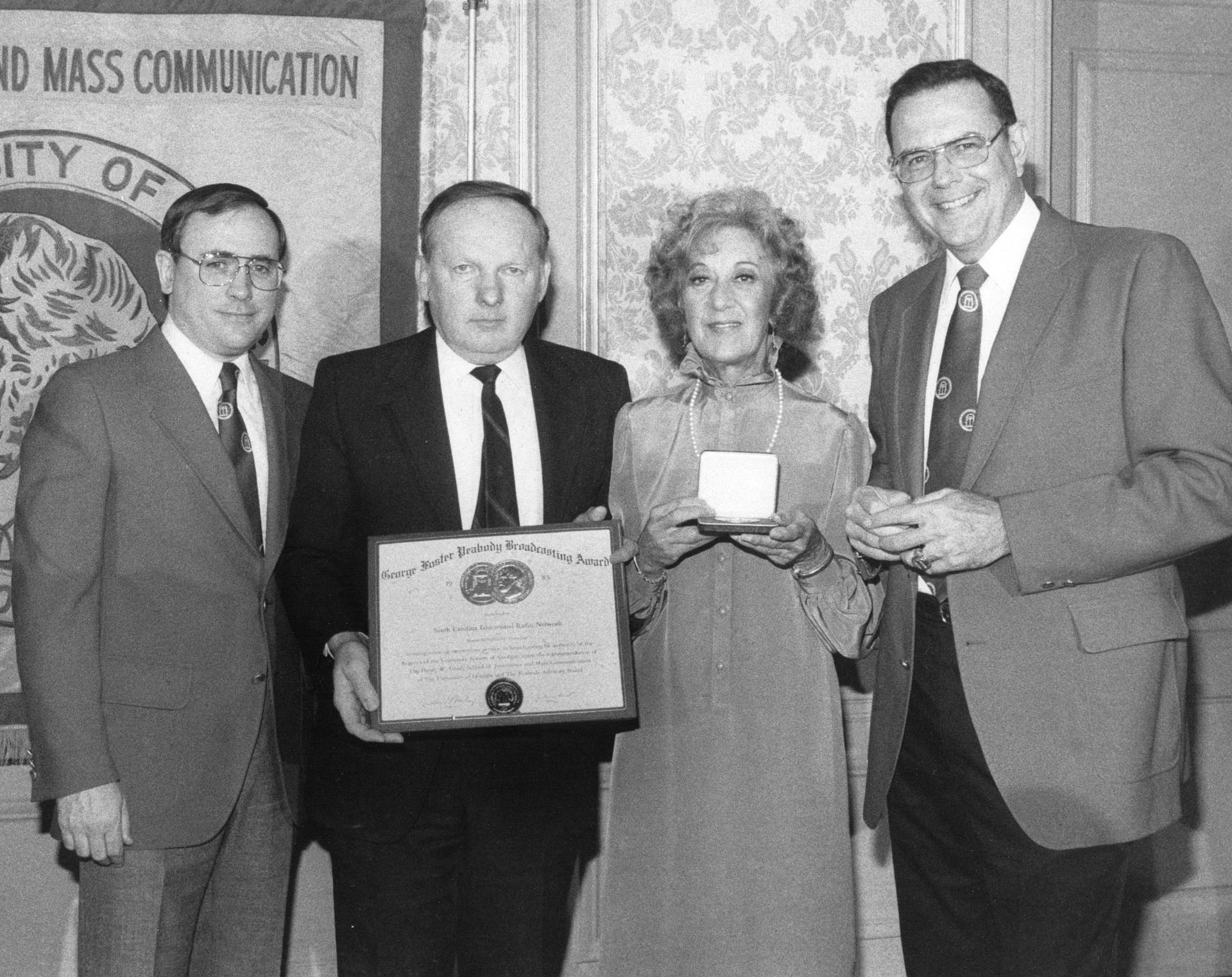
Lindsay the Leopard debuts as the agency’s mascot and SCETV hosts INPUT, the International Public Television Screening Conference. An additional station (WNEH) in Greenwood also signs on, and SCERN's Marian McPartland's Piano Jazz wins the prestigious Peabody Award.
1985
Shag, SCETV's classic film on the state dance, makes its debut. Locally, the series Vocal Lines explores operatic technique with host Dale Taylor.
1986
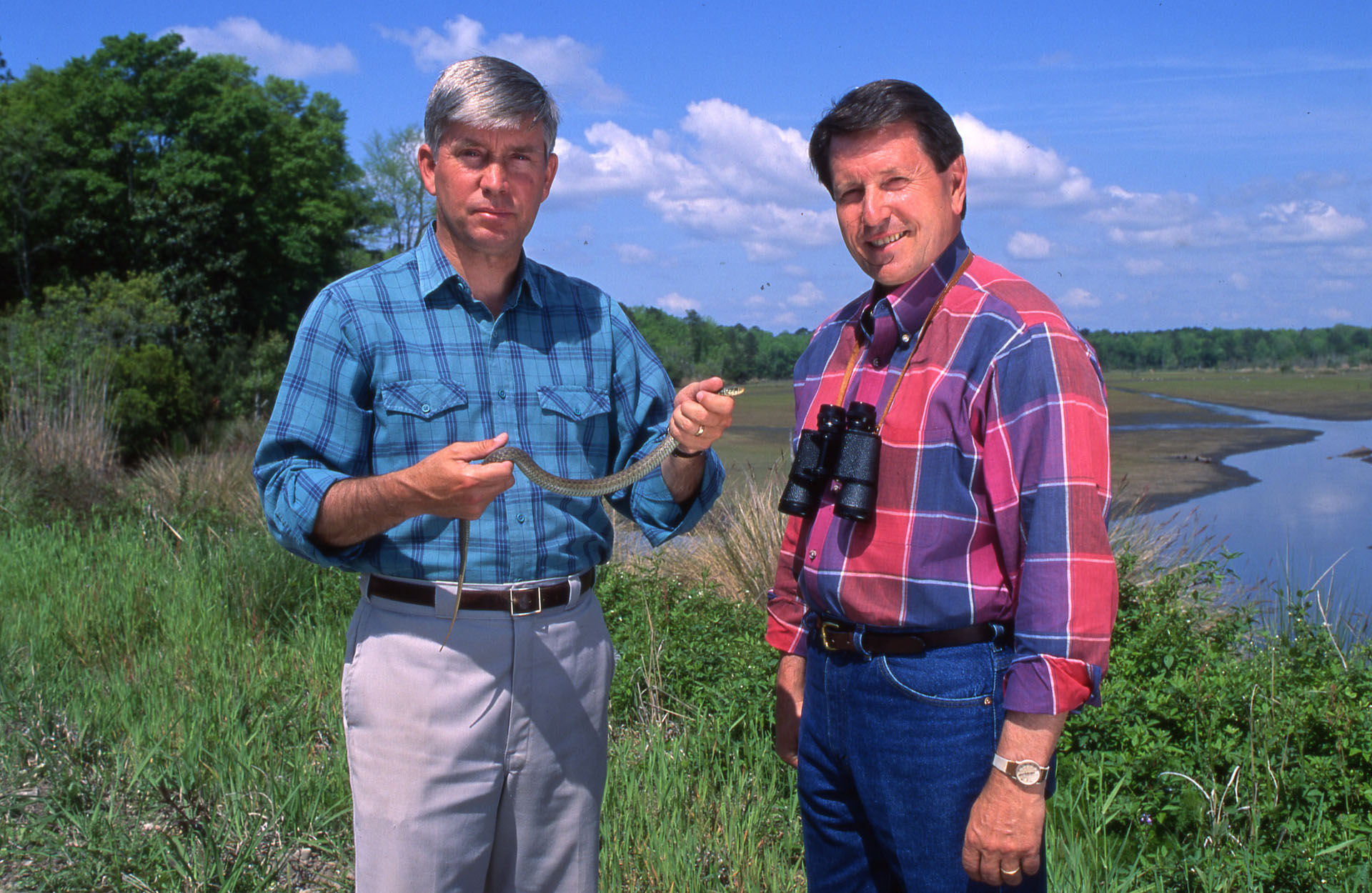
SCERN produces the national radio program Marion's Men: The Life and Times of the Swamp Fox, local series Schumann and the Piano from USC and Charleston Folk Concerts.
1987
SCETV produces Exxon Energy Cube, a nine-episode national classroom resource about energy, in addition to the local documentaries AIDS and South Carolina and Architecture: Shaping of Space. SCERN's new series include public affairs series Vu-Point and Notes from Home, which features local musicians.
1988
SCETV broadcasts The Black History Teleconference, connecting South Carolina with communities in Detroit, Atlanta and Washington, DC. Along with that, the 18-state Satellite Educational Resources Consortium, under SCETV President Henry Cauthen's leadership, receives a $5.6 million grant from the U.S. Department of Education to implement the Star Schools project, providing live, interactive instruction via satellite in math, foreign language and science.
1989
As SCETV wins its third Peabody for CE Newsmagazine and ranks as the busiest teleconferencing center in the nation, an additional station (WLJK-FM) signs on to the radio in Aiken. SCETV and SCERN also provide up-to-the minute coverage of Hurricane Hugo, broadcasting a three-hour flyover of the coast repeatedly so viewers can see if their homes and businesses survived. Additionally, Jobman Caravan celebrates its 20th anniversary, with a slightly different spelling and Ten Bites of the Big Apple follows South Carolinians who succeeded in New York City in business, on Broadway, and in the art world. SCERN also debuts ArtScene for and about local arts, and Main Street Jazz moves to radio.
1980s Gallery
1990
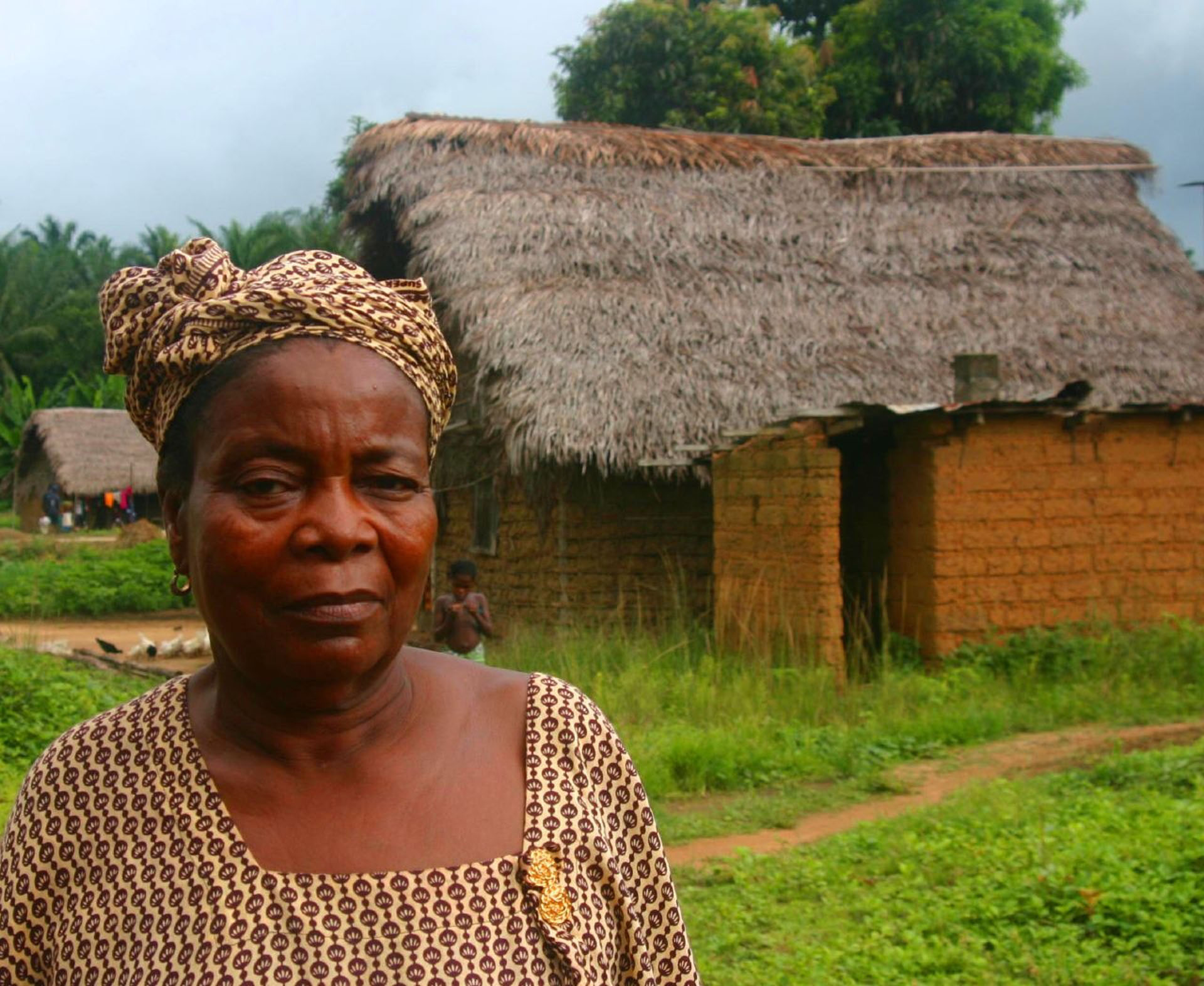
After the catastrophic damage from Hurricane Hugo, Charleston television service is restored. Windswept Hearts, a live call-in simulcast for radio and TV, helps South Carolinians deal with the emotional aftermath of the storm. Via the Star Schools project, SCETV also transmits teachers live to more than 10,000 classrooms, teaching Russian (with native Russian teachers), AP Economics, and AP Calculus. Additionally, SCETV's documentary on Modjeska Simkins, Makin' a Way out of No Way, premieres, and Family Across the Sea definitively traces the basket weaving patterns found at the Charleston marketplace back to Africa. The documentary becomes a permanent part of the Smithsonian exhibit on African art. Additionally, President Henry Cauthen is nominated to the Corporation for Public Broadcasting board by President George H. Bush.
1991
A town hall with Bill Moyers from Columbia's Longstreet Theatre is abruptly altered at the request of PBS and becomes a live, impromptu national town hall meeting after the sudden launch of Operation Desert Storm in the Persian Gulf earlier in the day. SCETV continues to broaden its educational spectrum by using its satellite and closed-circuit network to distribute 150 higher education courses statewide for college credit and train more than 1,000 law enforcement and correctional officers. Marian McPartland's Piano Jazz also produces its 200th episode. Additionally, On the Other Hand, a traditional telecourse, teaches sign language to teachers and health professionals and the Holocaust History Report and Conversations with South Carolina Writers are produced for South Carolina schools.
1992
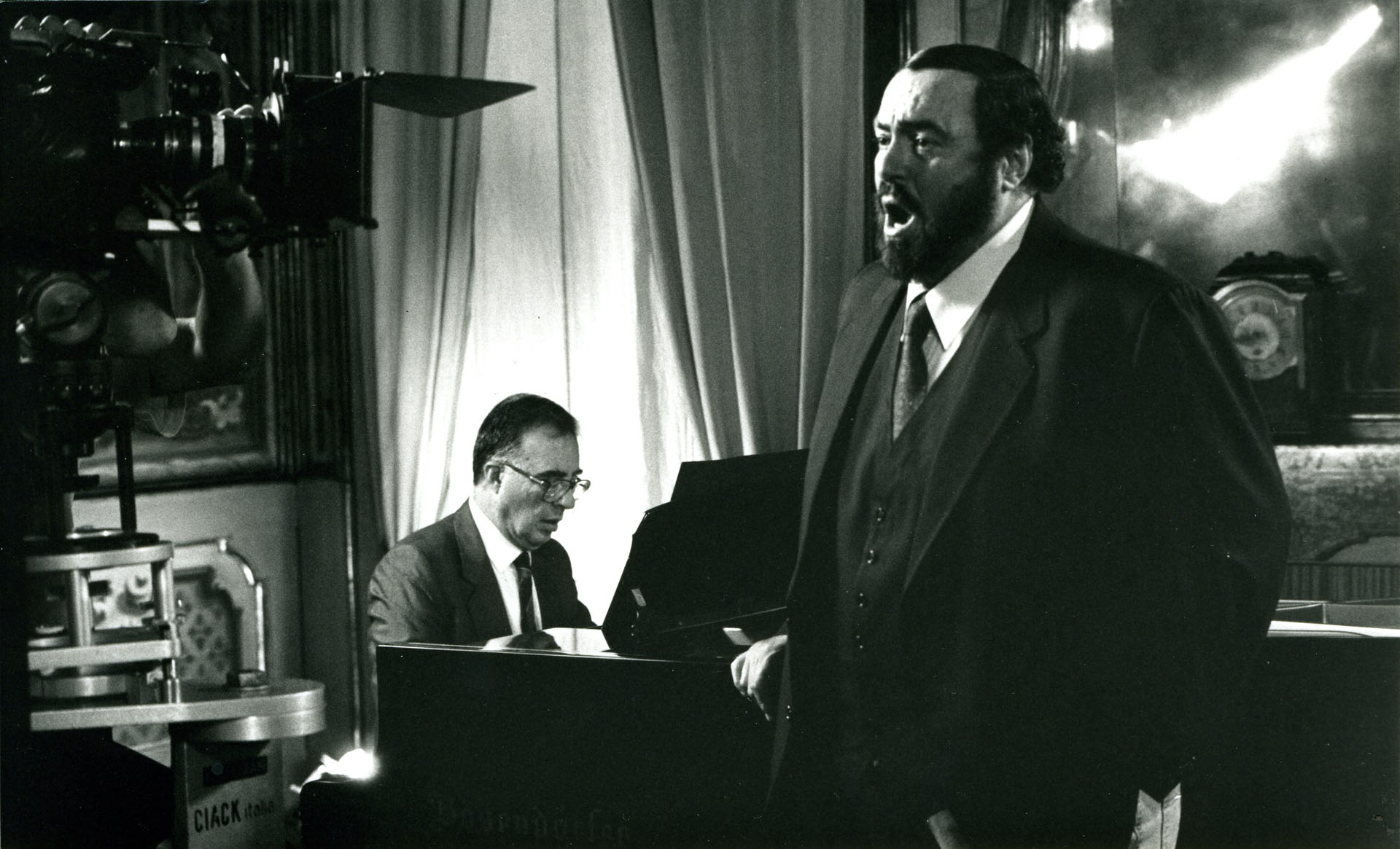
With a $2.4 million grant, SCETV launches The Early Childhood Professional Development Network, a national initiative that delivers live interactive training seminars to more than 1,000 Head Start teachers in isolated rural areas across the United States. SCETV's mascot Lindsay the Leopard makes a dramatic transformation into Smart Cat, and the staff begins the move to the new SCETV office headquarters on George Rogers Boulevard, previously the home of The State and The Columbia Record newspapers. In a first, The Corporation for Public Broadcasting also holds its annual meeting at SCETV, and the now-classic SCETV series from WRJA Sumter, The Writers' Circle, debuts. Additionally, the agency becomes the provider for South Carolina's first "cameras-in-the-courtroom" experiment and tapes 58 hours of oral history for the national Holocaust Museum. Spoleto Chamber Music Concerts also begins its tenth season.
1993
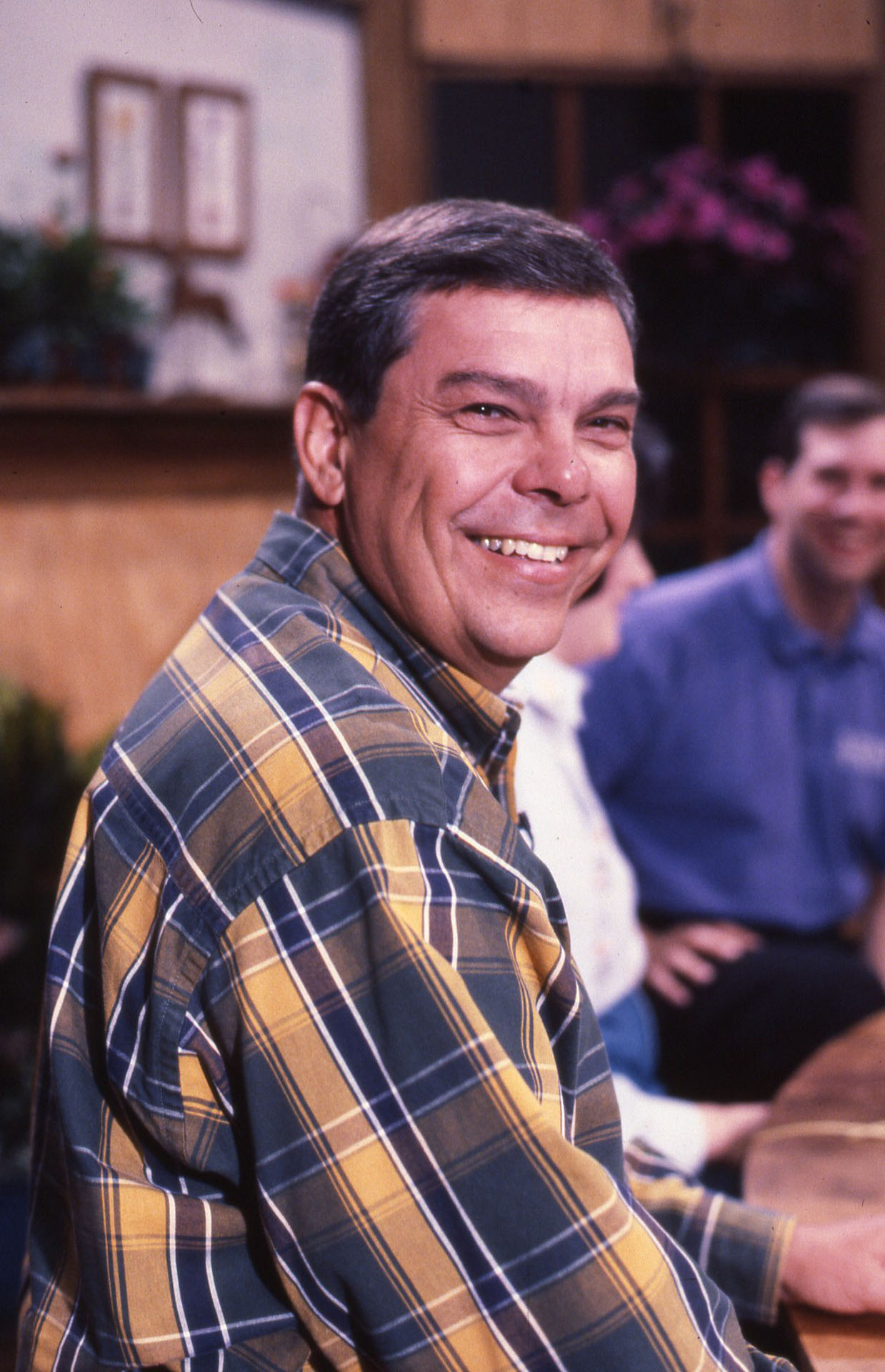
SCETV upgrades to a digital satellite system that allows 20 channels of two-way video and audio to schools, state government, and higher education institutions, including the Medical University of South Carolina and Richland Memorial Hospital. The South Carolina Educational Radio Network also produces a four-part series Old Time Religion. SCETV holds a 25th year celebration for Jobman Caravan, and the debut of Making It Grow! debuts from WRJA with host Rowland Alston.
1994
SCETV begins construction of a new studio building at George Rogers Boulevard next to the SCETV office building. The ETV Endowment raises in excess of $4 million to purchase the property, which it will later sell to the state for one dollar. President Henry Cauthen is elected Chairman of the Board of Directors of the CPB Board.
1995
To continue engaging the educational system across the state, SCETV installs satellite dishes on every middle, high, and vocational school in South Carolina. Additionally, the agency begins Teacher Training Institutes statewide on new technologies and teaching. It also introduces its first World Wide Web site. Conjointly, SCETV's Learning Link begins internet service to middle school teachers.
1996
Community advisory committees around the state are created to ensure that SCETV engages with all communities in South Carolina. SCERN begins broadcasting 24 hours a day and presents the second season of The African-American Music Tree nationally. In partnership with the South Carolina Municipal Association, SCETV uses its system to train local elected officials.
1997

In addition to the 25th anniversary of SCERN, SCETV begins broadcasting and producing from its new studio facilities at 1041 George Rogers Boulevard. To celebrate the grand opening, SCERN host Marian McPartland and guest Bobby Short perform in concert at the studio. President Henry Cauthen announces his retirement and is given the Lifetime Achievement Award from the Corporation for Public Broadcasting. It is only the second time the award has been given in that organization’s history.
1998
Paul Amos takes the helm as SCETV's president after the retirement of Henry Cauthen. SCETV also launches the READY TO LEARN service to help meet the state's challenge of preparing South Carolina's children for first grade. Additionally, three-time Emmy winner Jobman Caravan ends a nearly three-decade run with the retirement of host Bill Terrell. Connections, with host P.A. Bennett, also debuts.
1999
Locally, SCERN provides wall-to-wall coverage of Hurricane Floyd and debuts Slavery in Early South Carolina and Hanging on to my Baton with conductor Nicholas Smith. Additionally, Just Ask Us, a radio call-in program, debuts and later becomes the popular series, Your Day. Talkabout, from the College of Charleston, with host Nicholas Drake debuts. NatureNotes with Rudy Mancke and Making It Grow! also make their radio debuts. Along with that, Making It Grow! wins the Emmy for Interview/Discussion Program.
1990s Gallery
2000
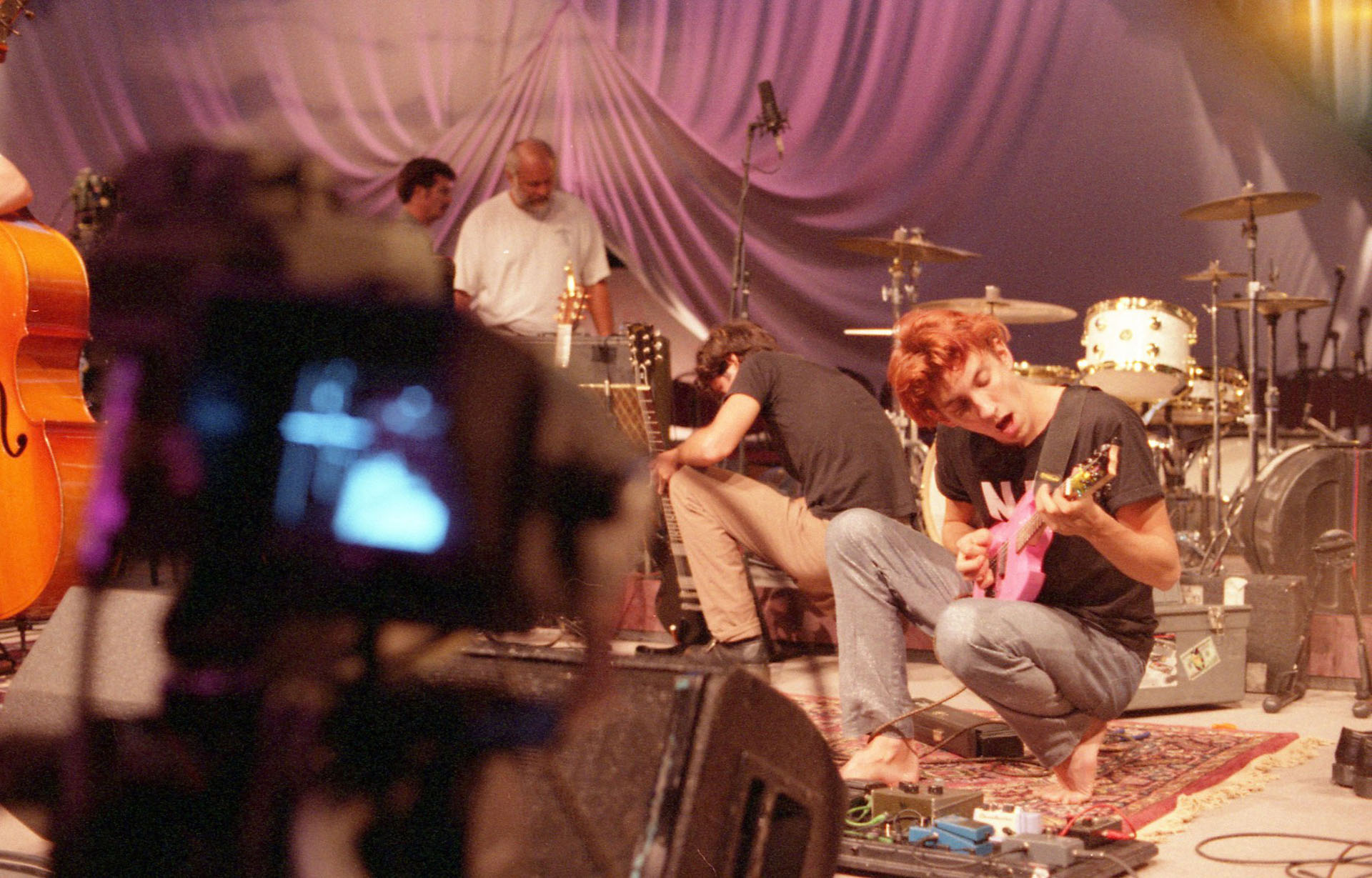
As the South Carolina Educational Radio Network (SCERN) continues to expand its coverage, the network begins broadcasting multiple formats, using either NPR News or NPR Classical/News formats. SCERN also adds full programs to its website, and premieres Walter Edgar's Journal and his audio book South Carolina: A History. Additionally, WRLK-DT, SCETV's Columbia station, becomes the first digital television station in the state.
2001
After the unexpected passing of President Paul Amos, Maurice "Moss" Bresnahan joins SCETV as the network’s new president. SCETV's web-based instructional service to schools, KnowItAll.org is also launched. Along with that, the agency holds an open house to explain digital television, more than 10,000 viewers and listeners attend.
2002
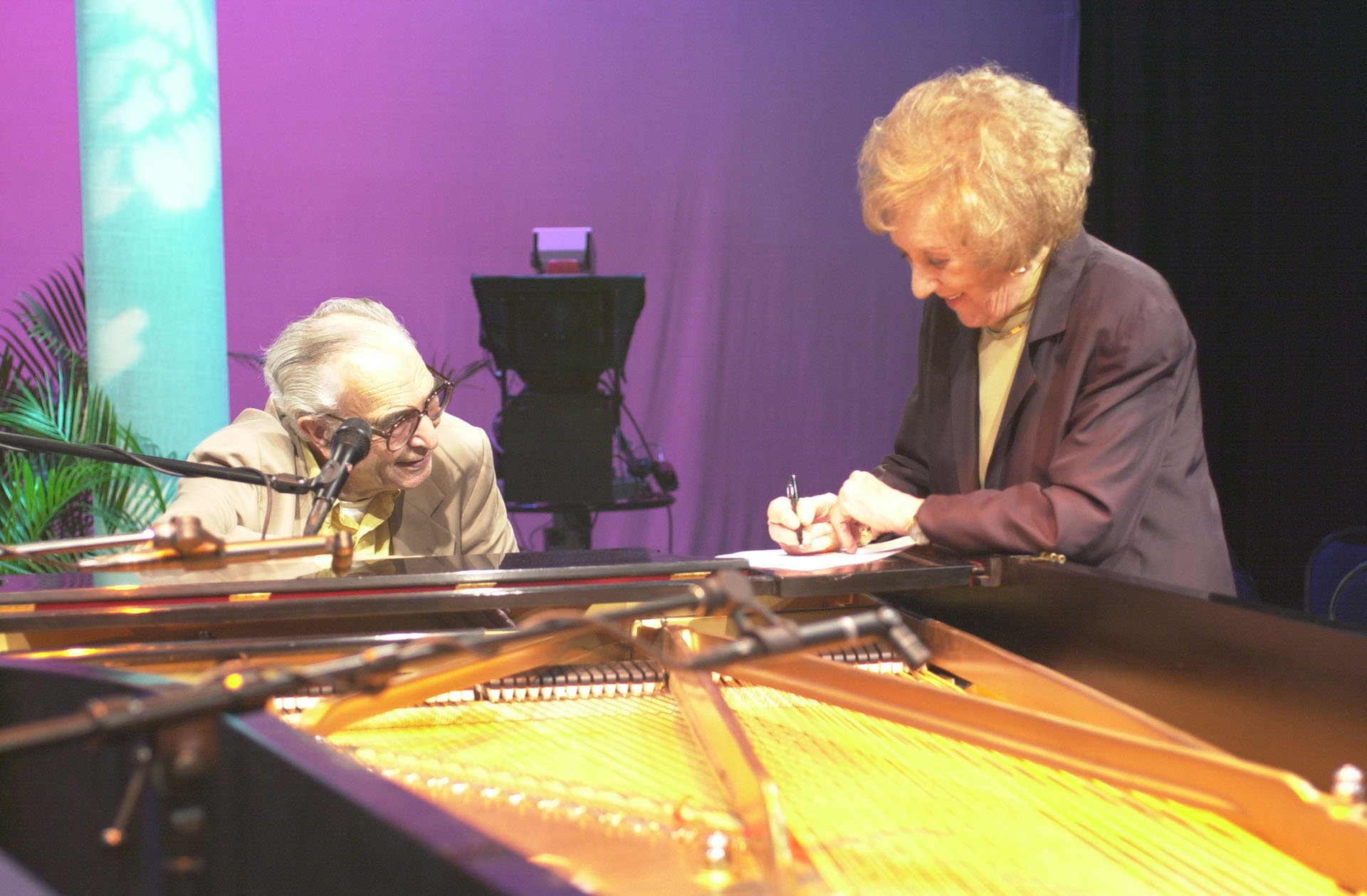
SCERN celebrates its 30th anniversary with Marian McPartland and Dave Brubeck in concert from the SCETV studios. SCERN also debuts Partisans and Redcoats, a new audiobook series from Walter Edgar. SCETV debuts new local series Southern Lens, which spotlights independent films that reflect life in the South and/or were produced by Southerners. Gullah Tales debuts on the web for classroom use.
2003
The South Carolina Channel, SCETV's first digital channel, launches at the State Fair as the agency embarks on a "Roadshow," traveling across South Carolina for special broadcasts. Additionally, IFRA, the World Association of Newspapers and News Publishers and the University of South Carolina create a $2 million media training studio for journalists at SCETV. SCERN is also renamed ETV Radio.
2004
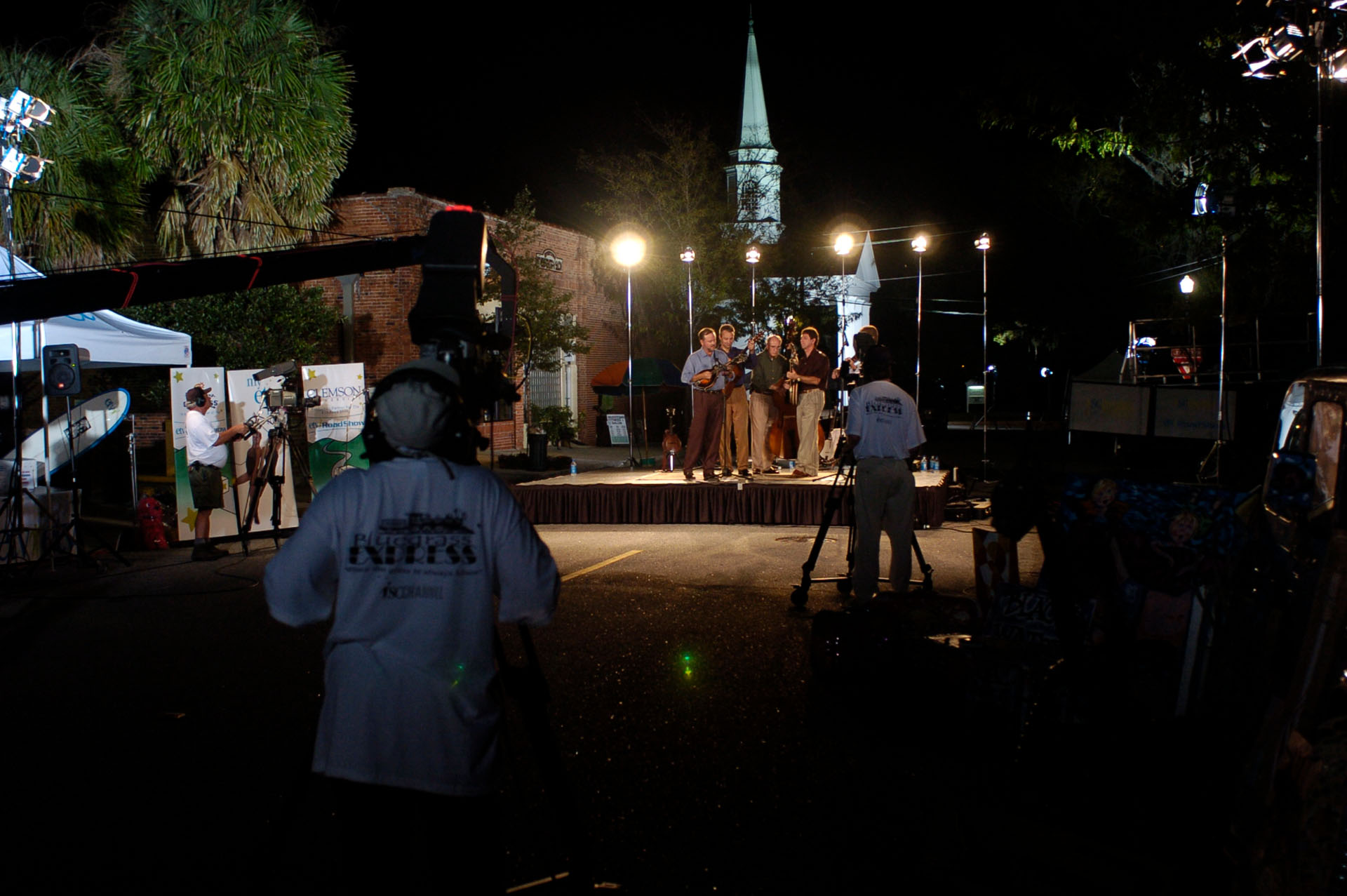
SCETV launches StreamlineSC, an educational technology resource that makes more than 10,000 educational videos and corresponding lesson plans and quizzes available to every public, private, and home school in the Palmetto State. Along with that, Roots Musik Karamu celebrates 25 years and the program Stay a Little Longer ends.
2005

An exploration of South Carolina watersheds, RiverVenture.org launches as a part of KnowItAll.org. Science Splash!, a science festival at SCETV studios, is attended by 1,800 students.
2006
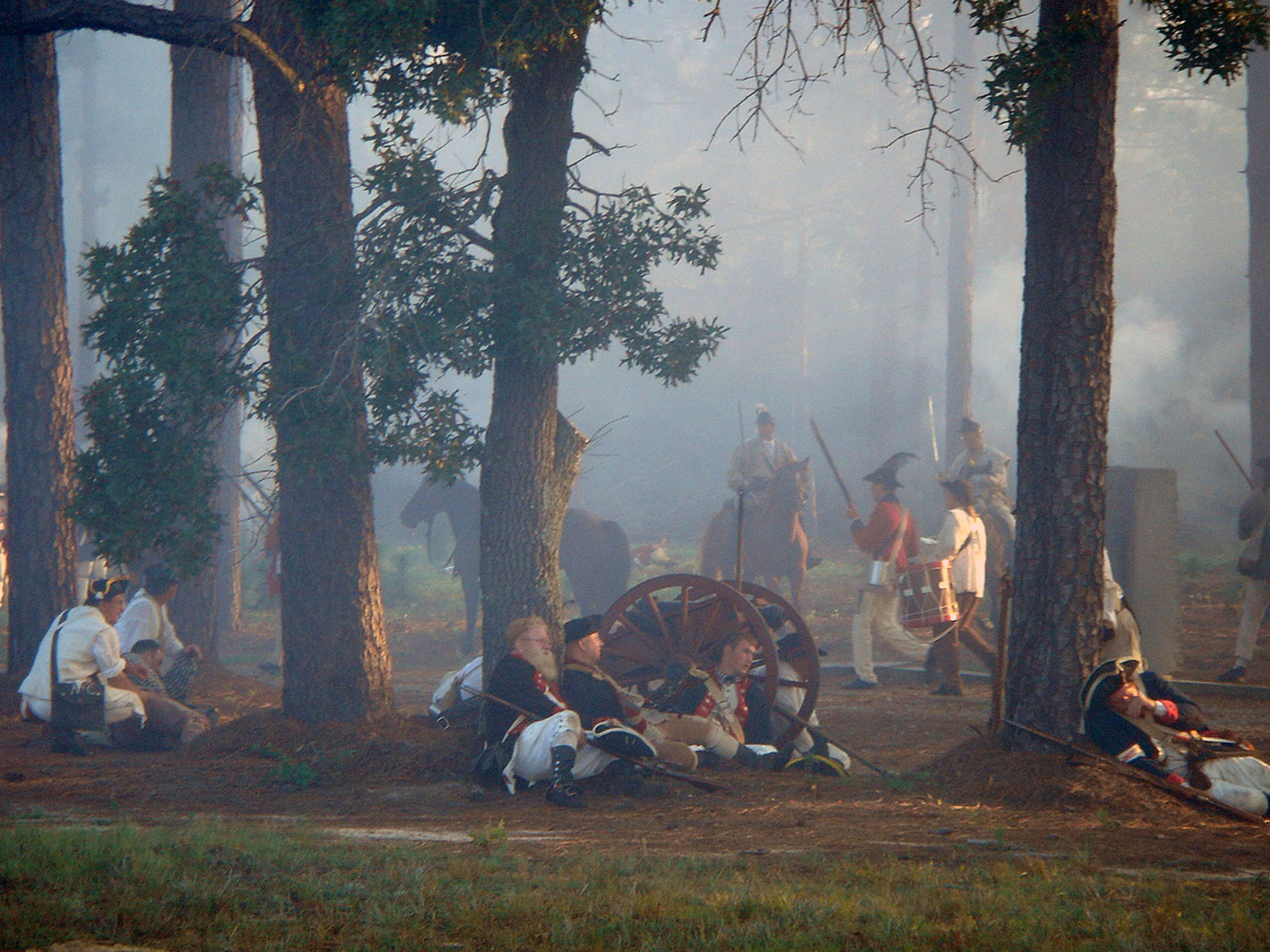
As Smart Cat commits to a healthier lifestyle, slims down, and begins leading exercises on air and StreamlineSC reaches its one millionth hit, the agency continues with its “Roadshow” covering the Lowcountry and the foothills. Additionally, Making It Grow! wins its third Emmy.
2007
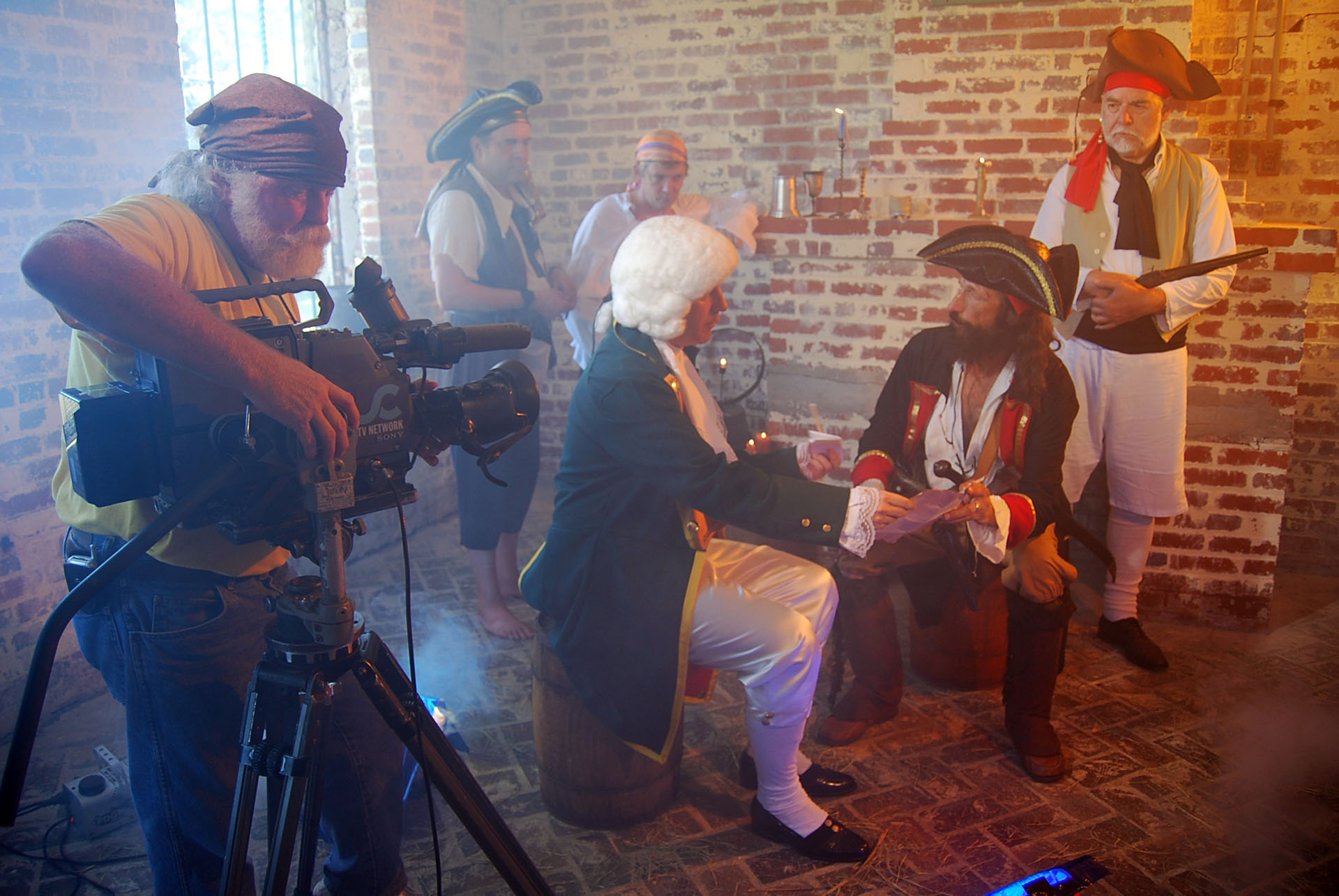
New local series The Big Picture and The Big Picture on the Radio are launched, including a program that features a panel discussion with five former South Carolina Governors. Making It Grow! wins an Emmy for scenic design. Online, Road Trip! Through SC Civil Rights History is launched, and students spend September cruising down the Broad and Congaree Rivers with Richard Bernabe blogging live.
2008
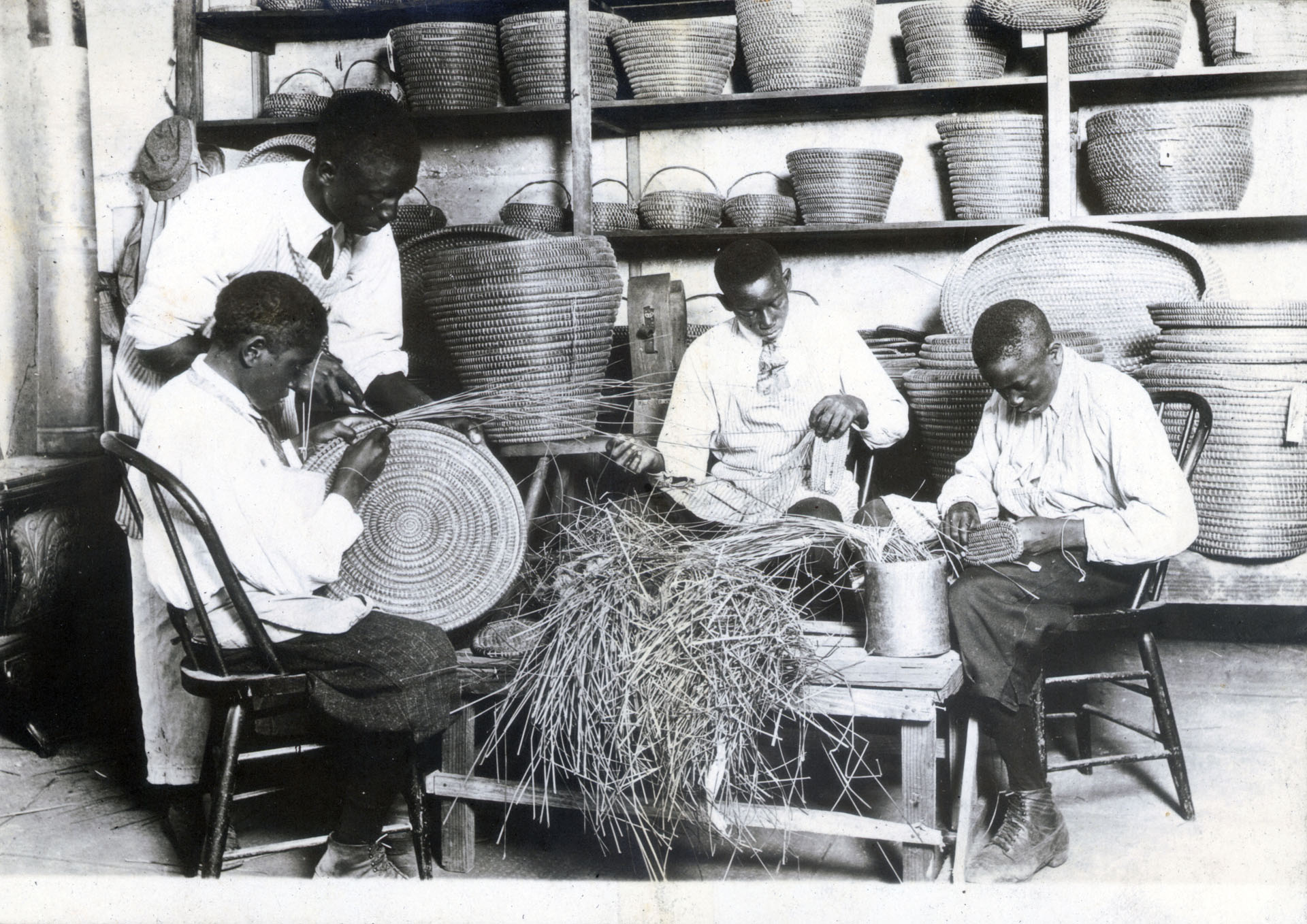
As Making It Grow! celebrates 400 episodes, SCETV welcomes David Crouch as the interim president and celebrates the retirement of ETV Endowment Founding Executive Director Elaine Freeman. Furthermore, SCETV and ETV Radio provide the only statewide coverage of GOP and Democratic Party conventions. Pirates of the Carolinas wins an Emmy for set design, and Career Aisle is launched online.
2009
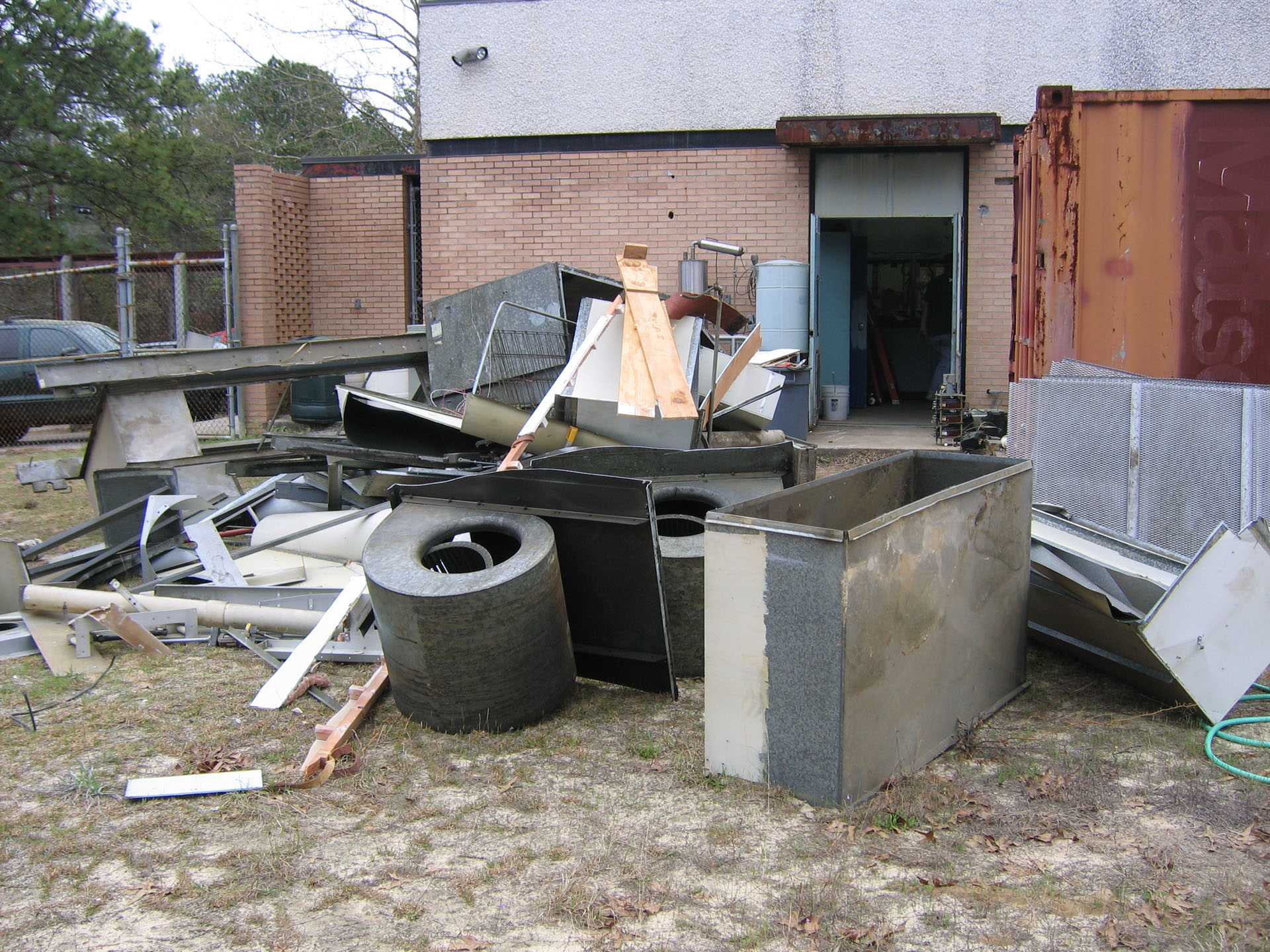
Upon Elaine Freeman’s retirement, Coby Hennecy is named the Executive Director of the ETV Endowment. Additionally, SCETV ends its analog television broadcasting service and ETV Radio begins streaming online. Carolina Stories: Carolina Caught debuts as SCETV's first high definition documentary and The ETV World channel is launched for live State House coverage and live newscasts from Europe. Roots Musik Karamu celebrates 30 years.
2000s Gallery
2010
Linda O'Bryon is named President and CEO of SCETV. The agency is awarded regional Emmys for Making It Grow: Scott's BBQ, Carolina Caught, Take on the South, and Incident at Mars Bluff. Additionally, online, Web of Water, fotonovela La Ropa Sucia, and NatureScene Interactive debut. ETV Radio partners with WDAV to produce Carolina Live; local symphonic performances in North and South Carolina and debuts Legacy of Opera and EarthSense. New local SCETV productions include the 500th episode of Making It Grow! and the premiere episode of South Carolinians in World War II, and Jail, No Bail.
2011
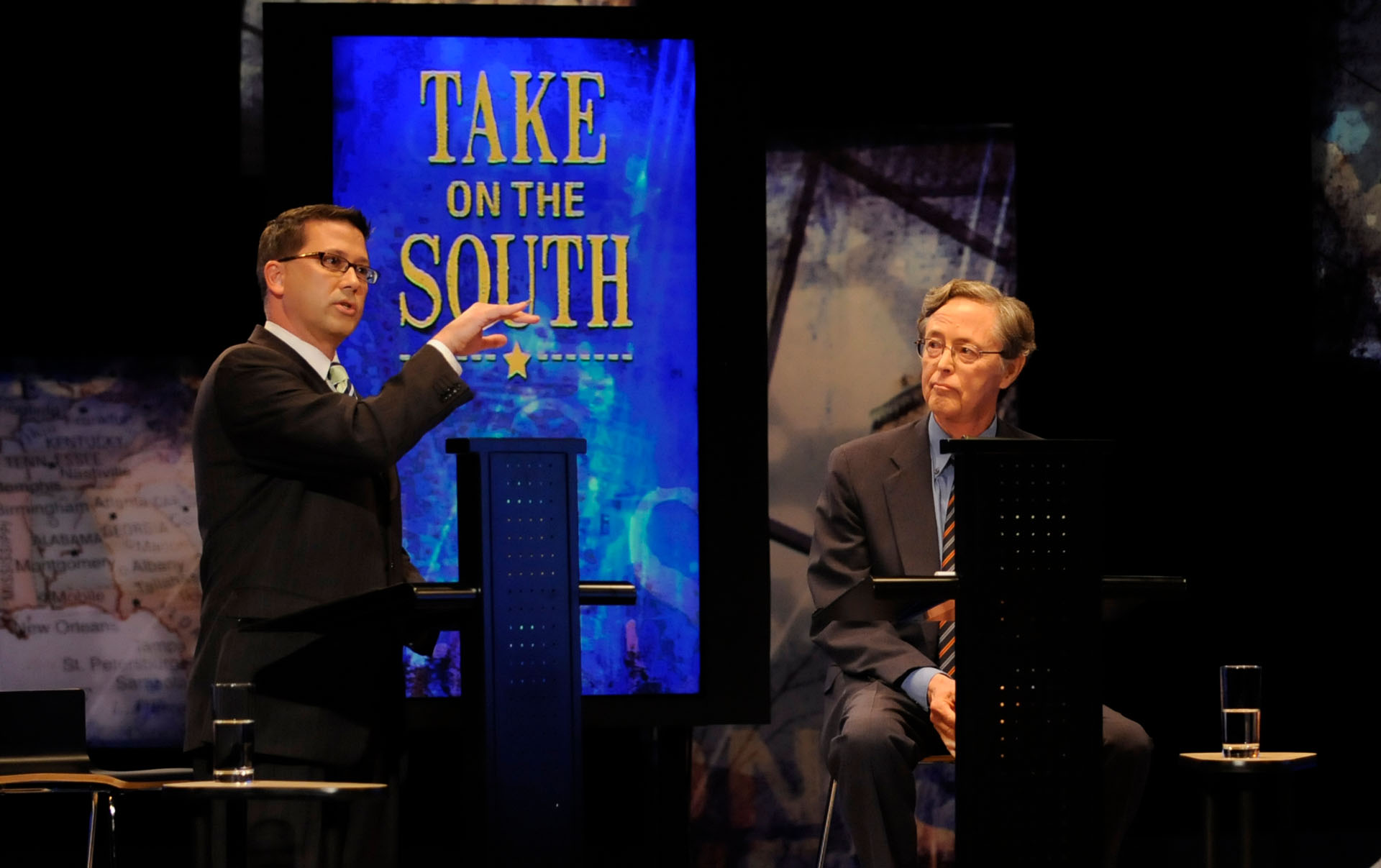
Following a successful ETV Endowment capital campaign, ETV Radio moves into a new $1.5 million dollar facility funded by corporate underwriters and over 1,000 ETV Endowment donors. The production of Piano Jazz: Rising Stars begins for NPR, while NPR's Performance Today features ETV Radio recordings of Spoleto on its national broadcast. New local radio productions include the debut of A Minute with Miles. Live State House coverage also expands to include streaming committee meetings online – a first for the agency.
2012
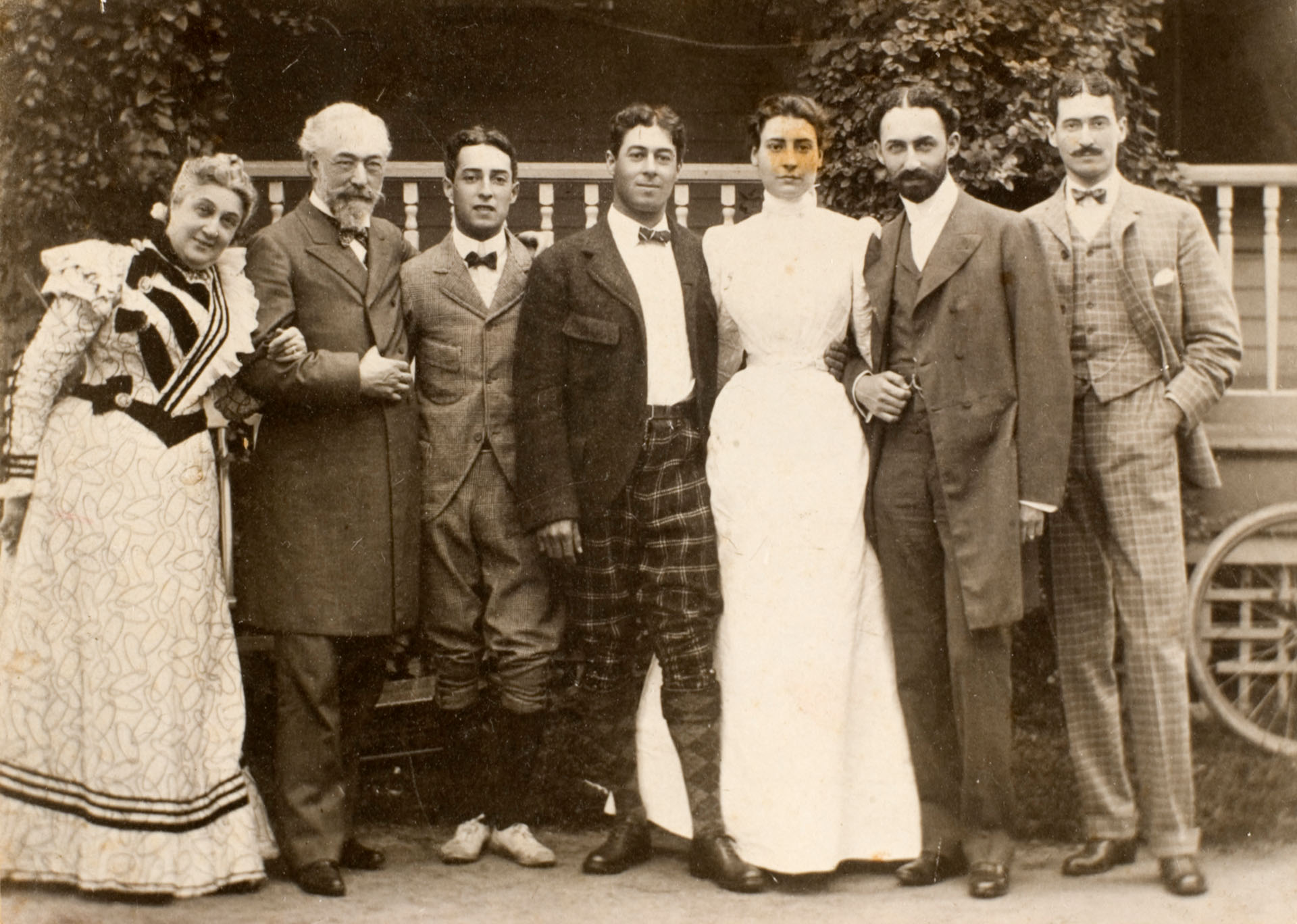
After four decades of providing South Carolina with information and entertainment, ETV Radio celebrates its 40th anniversary. Antiques Roadshow (from Myrtle Beach) and Story Corps (from Charleston) record in cooperation with SCETV and ETV Radio. SCETV's Administration Building is sold to the University of South Carolina, and the proceeds will be used to renovate and build-out unfinished areas of SCETV's Telecommunications Center. Additionally, SCETV's Rapid Response Studio begins operation. Rowland Alston retires as host of Making It Grow! and receives The Order of the Palmetto, the state's highest award. President and CEO Linda O'Bryon is named to the PBS board.
2013

To produce more classroom content, SCETV partners with PBS LearningMedia. Digitally, ETV Radio hosts American Chamber Players from Spoleto including student seminars. New local SCETV productions include the debut of Palmetto Scene with a new national presentation the inaugural season of A Chef's Life.
2014
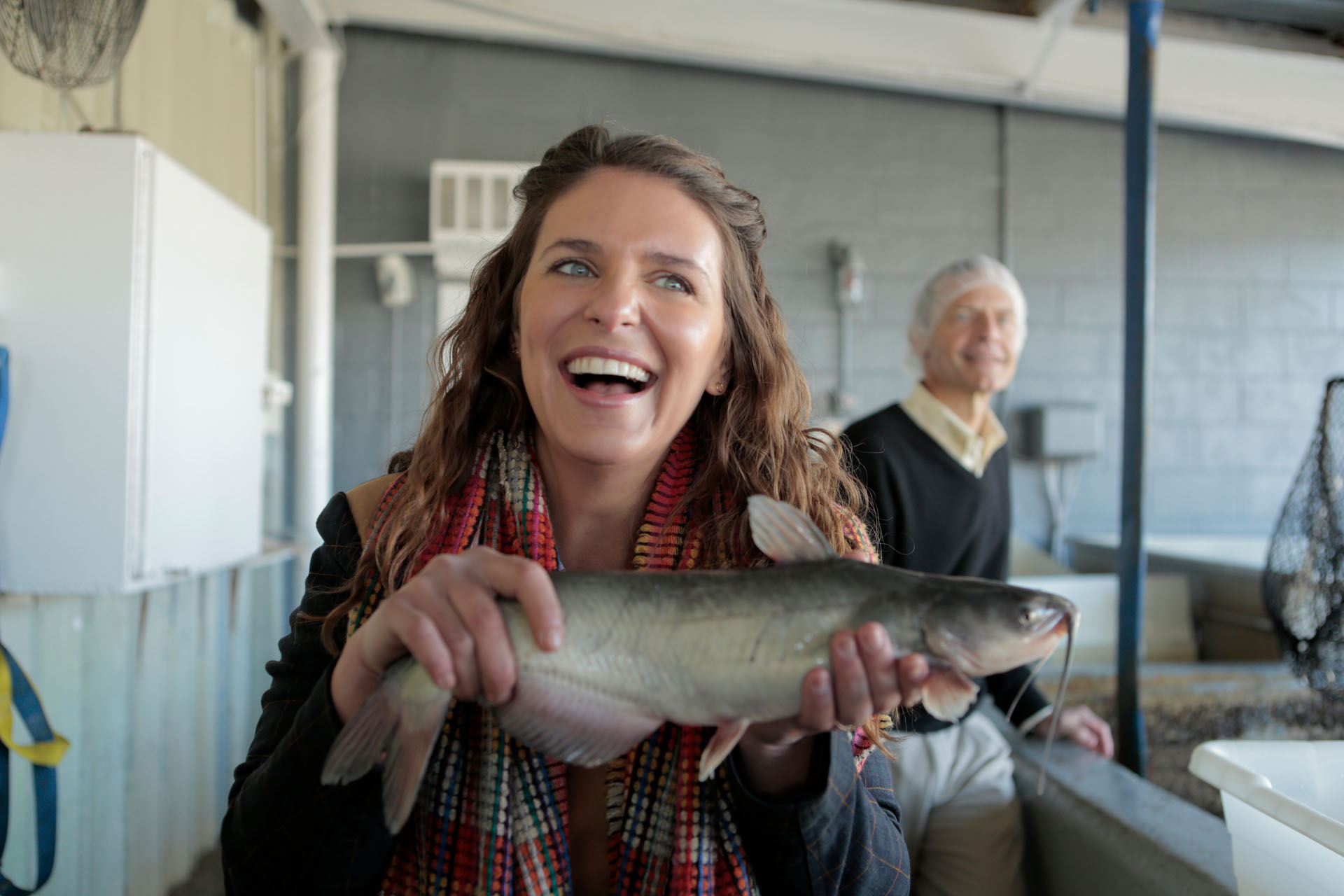
A Chef's Life on PBS wins SCETV its fourth Peabody award. The agency also launches a new website devoted to Hobcaw Barony, a privately owned research reserve. ETV Radio reaches a new digital height by adding a live classical music program, launching an iTunes app, and beginning the international distribution of Chamber Music from Spoleto Festival USA. Additionally, Song Travels with Michael Feinstein wins a New York Festival award.
2015

ETV Radio is renamed SC Public Radio. Antiques Roadshow and America After Charleston, both PBS productions, are hosted by SCETV in Charleston. Amidst a tragic massacre during the summer, SCETV's cameras provide worldwide coverage, including BBC and DWTV, for both the Emanuel AME funeral and the furling of the Confederate battle flag on the State House grounds. Online, Carolina Money launches. SC Public Radio's local productions include Health Focus from MUSC in Charleston, Live at the Charleston Music Hall, and the network adds additional local reporters for news, weather, and feature reporting. SCETV's local productions include coverage of the tragedy at Charleston's Emanuel AME, A Seat at the Table, and the series debut of Carolina Classrooms.
2016

To reach national audiences, SCETV and SC Public Radio launch their own app. Additionally, SCETV joins with PBS NewsHour to train students in middle and high school-based reporting labs. SC Public Radio hosts StoryCorps in Columbia, and Here and Now broadcasts live from SC Public Radio's studios. Two radio programs -- The Bluegrass Sound (1989) and Guitars, Cadillacs and Hillbilly Music (2004) – ended production, and Health Focus with MUSC is named as a Top 10 medical podcast. New national SCETV presentations include: the series debut of Reel South, and the special Climate Change: A Global Reality with John King of CNN.
2017
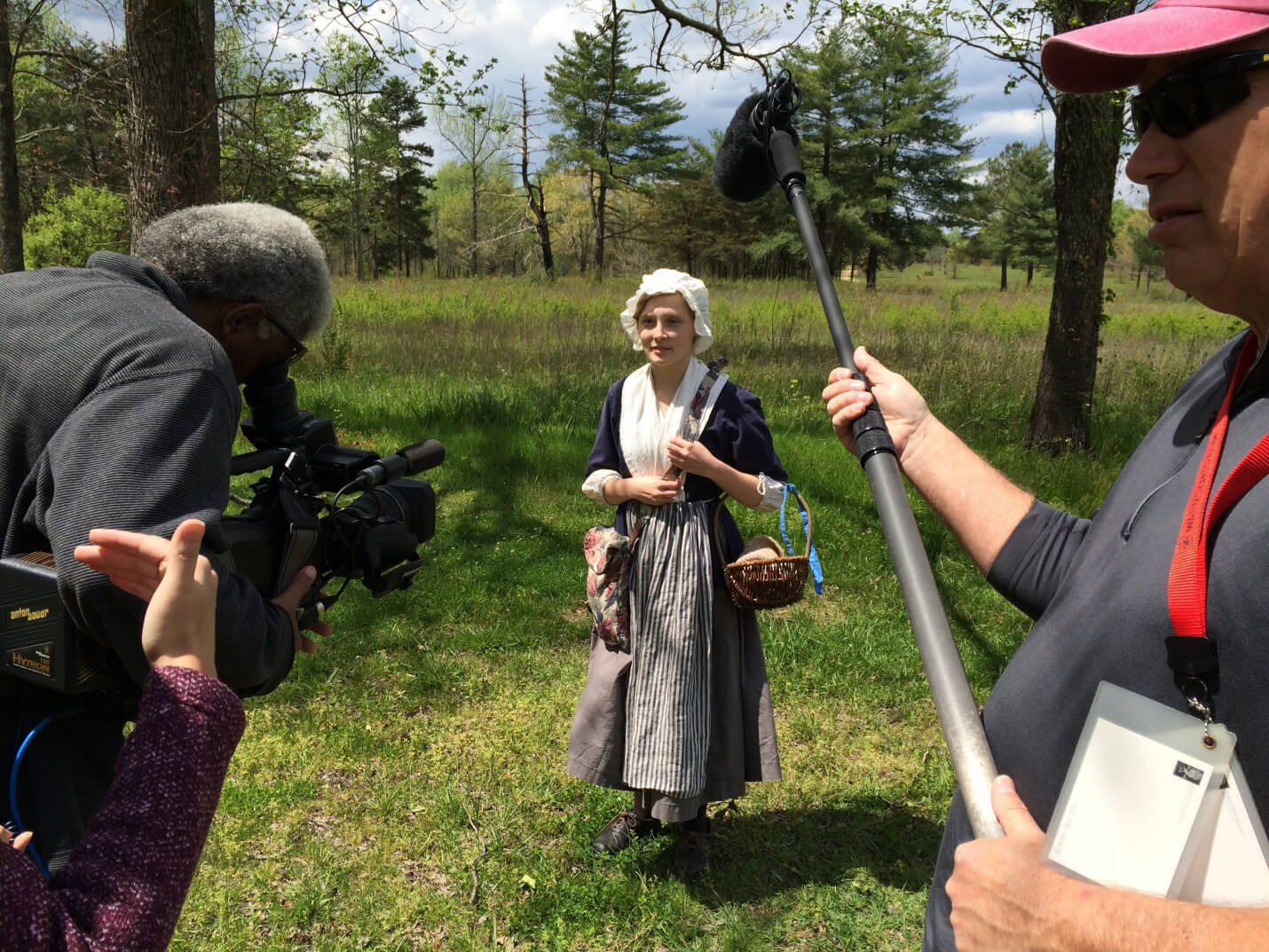
After four decades of the ETV endowment, a solar eclipse over the state, and the 25th birthday of the agency’s mascot, Smart Cat, SCETV continues its impact with a new face in leadership. Following the retirement of Linda O’Bryon, Anthony Padgett is selected as SCETV’s President and CEO. Along with that, a new online series for schools, The Southern Campaign of the American Revolution, charts the course of Revolutionary War history in South Carolina just after the fall of Charleston in 1780. In the national spectrum auction, SCETV’s Spartanburg spectrum is sold for $43 million, moving the proceeds to a special capital needs account. Additionally, SCETV launches the new LearningWhy website, which supports one-to-one learning and provides shared lesson plans. The network also launches the 24/7 SCETV PBS KIDS channel which also streams online. Local Emmy winners include: Remembering Charleston, Expeditions, and Live at the Charleston Music Hall. SC Public Radio also launches its first HD radio signal in Charleston.
2018
In addition to celebrating its 60th birthday -- and six decades of storytelling -- the network also commemorates 25 years of Making it Grow with a live taping at the Sumter Opera House. New local TV productions include: Our Town, By the River, Made Here, the SC Lede podcast, primary and general election debates and HBCU Rising. SCETV also produces The Orangeburg Massacre: Remembrances and Reckoning, a follow-up special to recognize the 50th anniversary of the massacre. The agency continues to reach national audiences as A Chef’s Life airs its final season, Reel South returns for its third season, Yoga in Practice debuts and the documentary Sea Change is distributed as part of "World" programming.
2019
SCETV kicks off the Federal Communications Commission-mandated Repack initiative with a public awareness campaign and successfully completes the required maintenance on seven stations. Additionally, the agency premieres several projects -- the Carolina Stories documentary Beyond Barbados: The Carolina Connection, which explores the connections between the Palmetto State and in the island nation of Barbados; a multi-platform initiative aimed at recognizing trailblazing women leaders called Women Vision SC; and digital series Backroad Bites, for which episodes premiered on SCETV's Facebook page -- a first for the agency. Looking to ramp up its efforts to serve as an essential resource to the citizens of South Carolina, SCETV launches it's new SCETVwx weather coverage service and collaborates with Sprint to establish more than 260 wireless hotspot locations in communities of need across the state.
2010s Gallery
2020
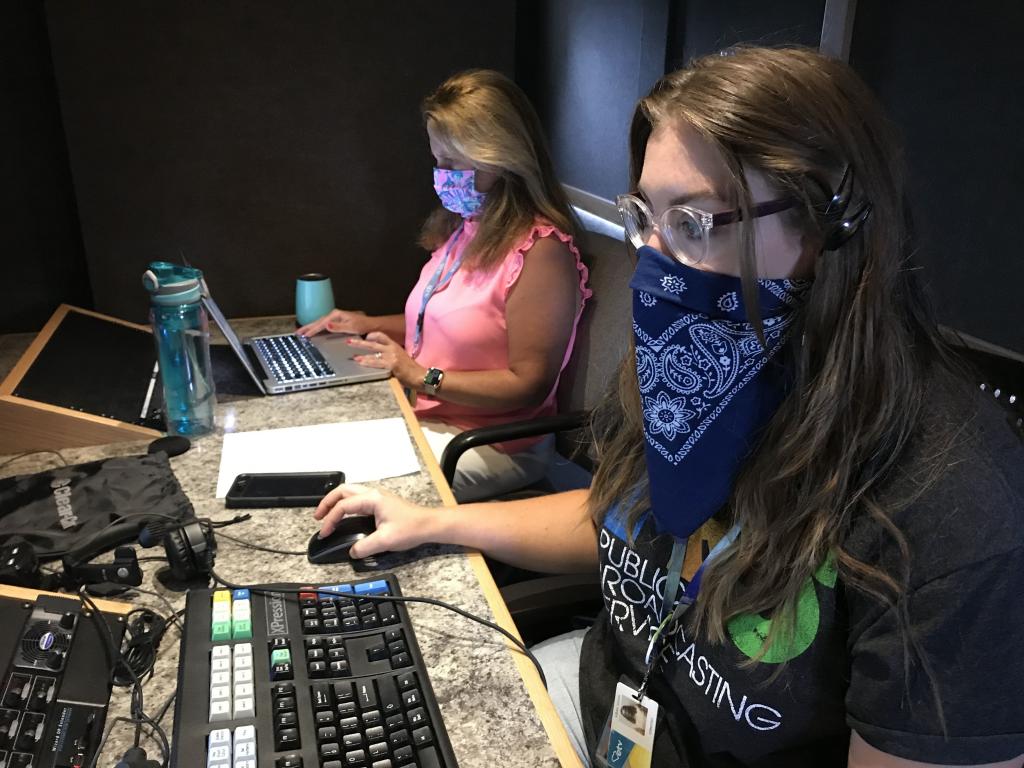
As the COVID-19 virus swept through the nation and caused a disruption in normalcy, SCETV found ways to continue accommodating South Carolinians. With schools closed and distance learning becoming a necessary tool, SCETV partnered with the S.C. Department of Education and SpectraRep to provide educational resources to families that lack broadband connectivity. Social media series, Storytime with SCETV also launched to keep students engaged throughout the summer. ETV Education started the SCETV Kids Club. Designed for children ages 12 and under, the Kids Club provides an opportunity for access to special SCETV Kids activities and events, free swag, and a whole lot more! What better way to stay connected to all things Smart Cat, ETV and PBS?
The agency announced its first livestreaming partnership with YouTube TV which includes episodes and on-demand content from PBS favorites. Additionally, SCETV premiered several projects – Palmetto Perspectives, a quarterly, issue-focused community discussion series; Gullah Roots, a documentary following the leaders of the Gullah Geechee community as they experience a homecoming in Sierra Leone; and Go For It, a digital South Carolina travel series. The network also ramped up its news coverage efforts in 2020, providing multi-platform coverage of the pandemic, the 2020 election cycle, ongoing protests of racial injustice and more.

2021
SCETV defined 2021 with extraordinary programs, news that was reliable and informational, educational initiatives focused on serving the underserved, and sparking community discussions. Two programs premiered nationally via PBS: Downing of a Flag, a two-hour, two-part documentary film that focuses on the Confederate Battle flag and its impact on the people, politics and perceptions of South Carolina and beyond, and How She Rolls, a half-hour lifestyle documentary and culinary series that follows the life of Charleston, S.C. entrepreneur Carrie Morey. By the River is accepted for national distribution via APT. The network continues to provide local stories of impact including the launch of a new podcast, De-escalating Disability, which explores the intersectionality of race, policing and disability. A new digital series, From the Sky premiered on Facebook Watch offering viewers a glimpse into the cities and towns of South Carolina from a “not often seen” vantage point… from above. Another new digital-series, Carolina Snaps, provides 20 short-form videos on the history and culture of South Carolina. The Knowitall.org and Learningwhy.org websites are combined to create a streamlined, centralized experience for educators and families.
As part of continued efforts around diversity, equity, and inclusion, SCETV launched the Public Media Diversity Leaders Initiative (PMDLI), a national initiative created in partnership with the Riley Institute at Furman University.
President Anthony Padgett is named to the APT Board. Dr. Stephanie Frazier is named as the assistant general manager. Tabitha Safdi and Dr. Salandra Bowman are named as the agency’s first chief content officer and first chief learning officer, respectively. Tom Posey, retiring director of transparency, receives the Governor’s Order of the Palmetto Award. APTS honors the agency with an innovation award for its work in datacasting. The agency receives 13 Telly Awards, and is recognized as a Community Builder by the SC Department of Parks and Recreation. Reporter Scott Morgan receives an Edward R Murrow award for the second year in a row. SC Public Radio receives six awards through the SC Broadcasters Association.
2022
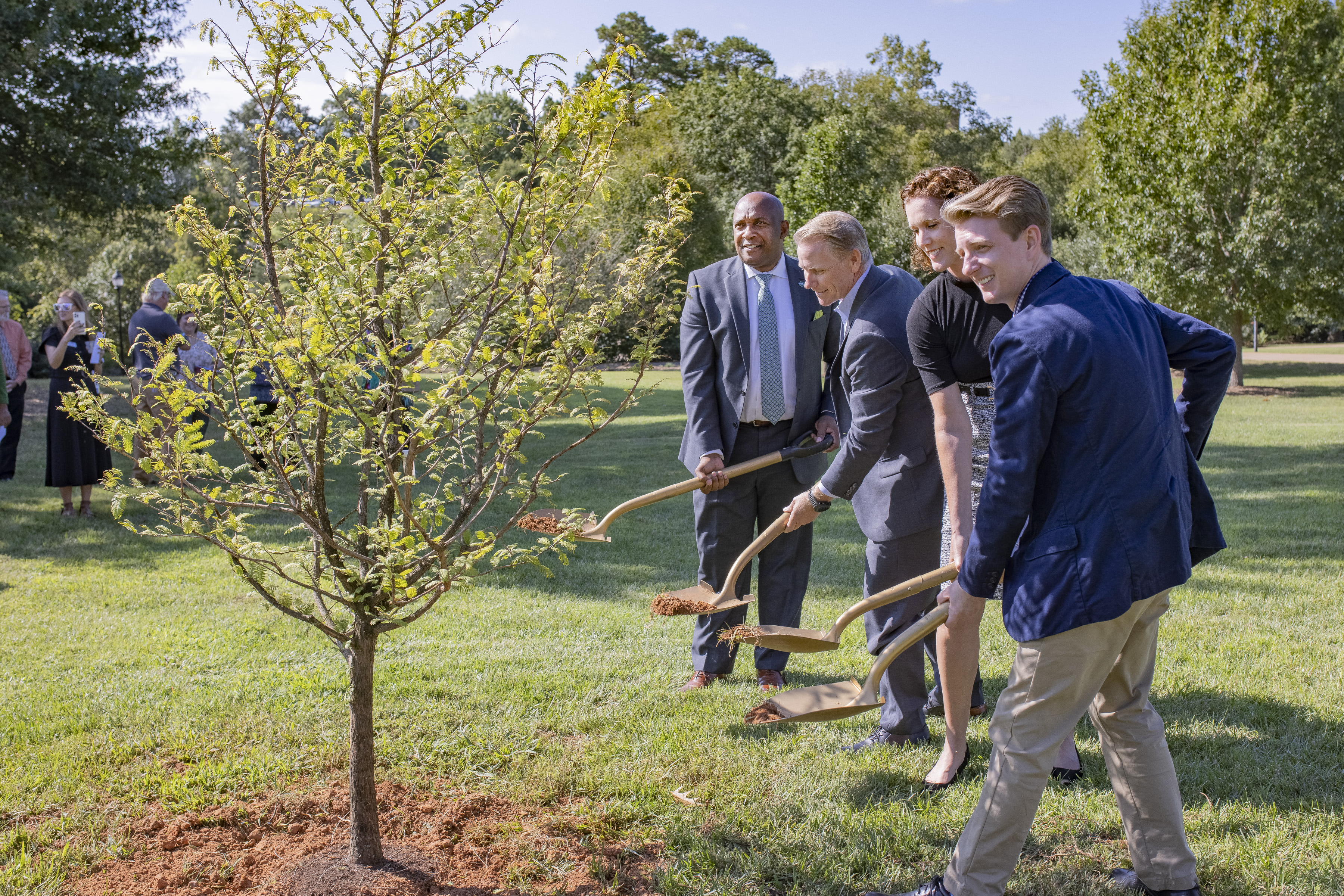
SCETV and South Carolina Public Radio kicked off a year-long celebration of the 50th anniversary of SC Public Radio programming in South Carolina. SC Public Radio’s Golden Jubilee began with the planting of a commemorative tree at USC Upstate in Spartanburg, SC, and followed with appearances at local community markets/fairs around the state.
The agency completed a new, three-year strategic plan which introduced a revised mission statement, vision statement, and values. In alignment with the new strategic plan, SCETV hosted its first two-day, offsite retreat focused on The Power in the Pause. Featured speakers included representatives from PBS, the Corporation for Public Broadcasting, Richland County Sheriff’s Department, and other community partners.
Landon Masters was named as the agency’s first Chief Public Information Officer, Ty Moody was promoted to Director of Digital and Sean Birch was promoted to Director of Radio. SCETV launched a new community engagement series, Indie Lens Pop-Up, which promotes films seen on Independent Lens, the award-winning PBS documentary anthology series. SCETV held four community screening events around the premier dates of five new documentary films that fight for greater diversity, equity, and inclusion, and ultimately a richer understanding of society. A new digital series, What’s Wild, launched to build upon the network’s legacy to showcase South Carolina’s rarest wildlife and the amazing people who protect them. Working in partnership with Twin Cities PBS, SCETV launched the Safe Space Initiative to address concern around rising suicide rates of adolescents in South Carolina. This initiative consisted of listening sessions, regional town halls and community workshops, and panel discussions.
SCETV and SC Public Radio received many awards for excellence and innovation, totaling 40 nominations or wins. SCETV’s two-part series, Downing of a Flag, was one of 60 programs nominated out of nearly 1,300 entries to receive a prestigious Peabody Award. This program also received a News and Documentary EMMY nomination for “Outstanding Historical Documentary” and won two Telly Awards, including a Gold award in the “Television - Use of Archival Footage” category and a Silver award in the “Television – Documentary” category. SCETV received a record 19 Telly Awards in total - four gold, seven silver, and eight bronze trophies. Five SCETV programs were nominated for Southeast Regional EMMY awards, with Making It Grow winning first place in the “Television Lighting” category. SC Public Radio was named the “Best of Charleston” by the Charleston City Paper in the “Best Talk/News Radio Station” category. Season four of By The River received an Award of Distinction from the 28th Annual Communicator Awards in the “Film/Video-Talk Show/Interview” category. SC Public Radio reporter Victoria Hansen was awarded “Radio Reporter of the Year” by the South Carolina Broadcasters Association for the fourth consecutive year. The SCETV and SC Public Radio news teams received seven first-place awards and eight second place awards from the Radio Television Digital News Association of the Carolinas (RTDNAC), including “Outstanding News Operation.”
In addition to the many awards that SCETV and SC Public Radio received, South Carolina Governor Henry McMaster was presented with the 2022 Champion of Public Broadcasting Award by America’s Public Television Stations (APTS). This award was given in recognition of Governor McMaster’s support and funding of SCETV and its educational datacasting initiative.
2023
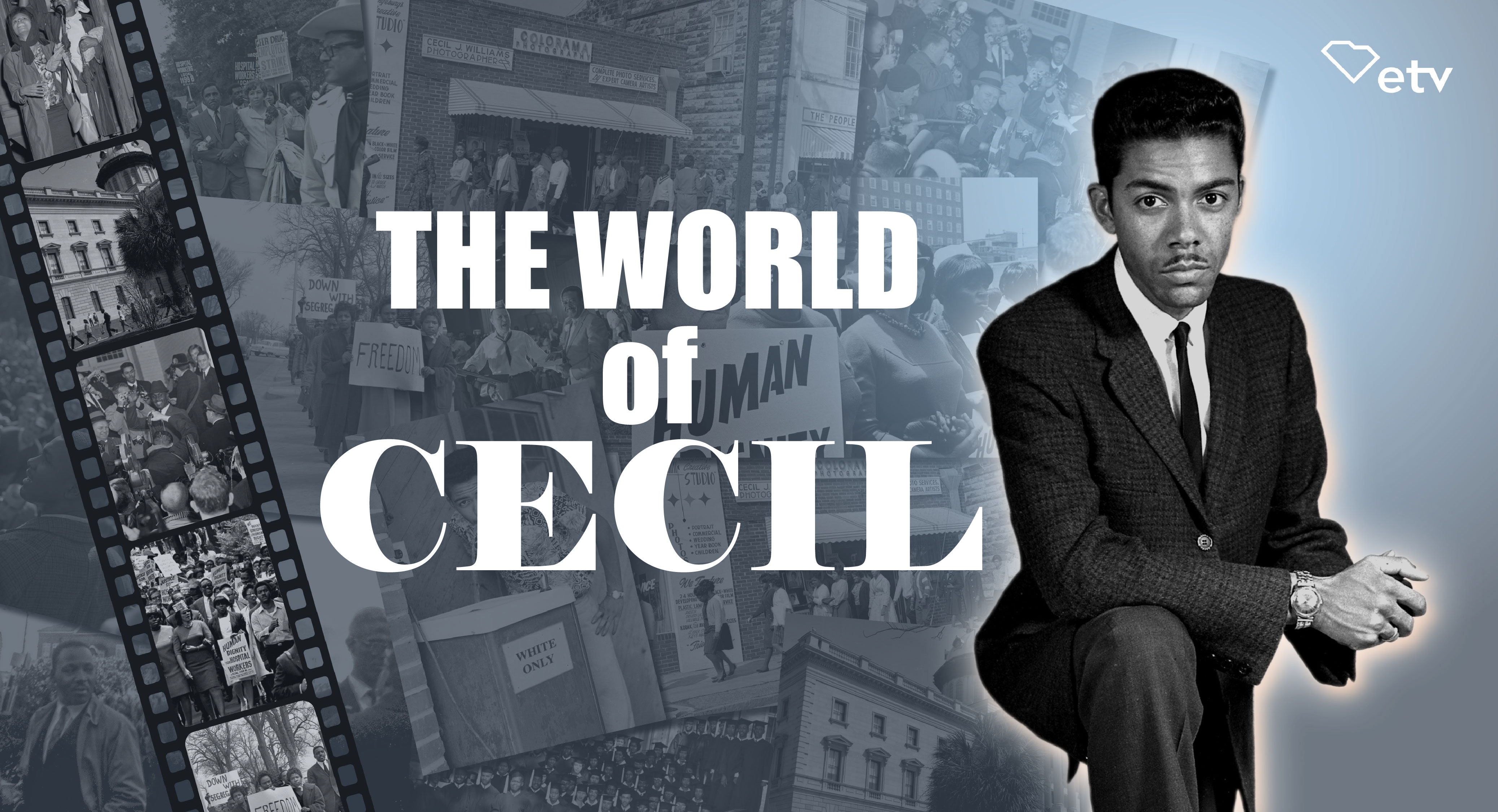
2023 was marked by both celebration and remembrance, showcasing the resilience and vibrancy of SCETV and SC Public Radio.
The content landscape saw the premiere of impactful documentaries and series. The World of Cecil honored the influential photographer and civil rights activist Cecil J. Williams, while Exposing Disparity: COVID-19's Lasting Impacts delved into the lasting impacts of COVID-19 on communities of color. Hosted by Scott Morgan, the podcast series InDebted premiered, exploring the issue of debt in South Carolina. SCETV Safe Space returned, addressing the complex landscape of social media and its impact on teen culture. The digital series Our Town returned with Season 3, highlighting the small-town charm of South Carolina, and What’s Wild returned for Season 2. Reconnecting Roots Season 3, Yoga in Practice Season 4, After Action Season 1, and By The River national Season 2 also premiered to audiences across the U.S.
Walter Edgar's Journal transitioned from broadcast to a podcast format and unveiled a Book Nook at All Good Books in Columbia, offering a curated selection of books discussed on the SC Public Radio podcast.
In January, SCETV broadcast and livestreamed the inauguration of Governor Henry McMaster. SCETV also kept viewers and listeners informed and prepared as Hurricane Idalia impacted South Carolina in August.
SCETV added to the many ways viewers can access content by integrating with Local Now in July and then with Hulu + Live TV in December.
Work was completed on the interactive and immersive educational website Reconstruction 360, using content modules in a 360° video platform as a storytelling device to let users step inside pivotal Reconstruction events.
SCETV held the first Wise and Wired workshop in September with the goal to boost the confidence of senior citizens using technology and ignite or rekindle their enthusiasm for the digital world.

The educational, scripted series, The Cool and the Strong premiered in August, followed by a documentary on the story behind the series titled Lights, Camera, Education: Behind the Scenes of The Cool and the Strong. You Can: A South Carolina Education Town Hall also discussed the state of education in the state and was hosted by Miss South Carolina Jada Samuel.
SCETV and the South Carolina Hospital Association announced a partnership to create multi-platform content and instructional resources that highlight careers in healthcare, hosting a signing ceremony to commemorate the collaboration in June. In July, SCETV and Attorney General Alan Wilson announced a partnership to support the creation of educational resources around the topic of human trafficking with TraffickProofSC and the South Carolina Human Trafficking Task Force.
SCETV continued a partnership with Furman University’s Riley Institute, with the start of the fifth and sixth cohorts of the Public Media Diversity Leaders Initiative.
SCETV's commitment to community outreach shone through initiatives. SCETV hosted the first Be My Neighbor Day in Greenville. The Palmetto Pencil Project collected supplies for teachers to use in their classrooms across the state, with regional studios serving as drop-off locations for local communities. Flow Fusion helped to celebrate 50 years of Hip Hop artistry, allowing youth to submit art in various categories. SCETV helped viewers celebrate America’s 247th birthday by hosting an online competition to win a watch party kit for A Capitol Fourth. In October, SCETV interacted with fairgoers and hosted a variety of activities as a permanent exhibit at the 154th Annual South Carolina State Fair. The Season of the Secret holiday campaign also educated viewers on various winter holidays and encouraged them to guess the identity of a secret, golden gloved “gift giver.”
Milestones abounded in 2023, including the 20th anniversary of the South Carolina Channel and the 30th anniversary of Making It Grow. A celebratory event was held in Sumter for Making It Grow in partnership with the ETV Endowment where host Amanda McNulty reminisced with past colleagues from the show. Thelisha Eaddy's historic role as the first female African American host of SC Public Radio's Morning Edition marked a significant achievement in its 50-year history.

SC Public Radio’s 50th Anniversary celebration concluded in September with a concert in Rock Hill featuring the Steep Canyon Rangers following an Open House in May and an honorary luncheon in March where Rudy Mancke, Osei Chandler, and Walter Edgar received Legacy Awards for their contribution to SC Public Radio’s history.
SCETV and SC Public Radio saw the loss of two influential figures. Miles Hoffman, a renowned SCETV classical music commentator and musician, passed away in August. His insightful commentary on classical music through A Minute with Miles enriched the cultural tapestry until his passing. Rudy Mancke, the celebrated naturalist and host of SCETV's NatureScene and SC Public Radio's NatureNotes, also passed away in November. In December, SCETV premiered a live studio production called Remembering Rudy…, bringing together former colleagues and friends to discuss Mancke’s legacy.
Awards for excellence and innovation poured in with SCETV and SC Public Radio receiving over 40 nominations or wins. Among the accolades were 13 awards from the Radio Television Digital News Association of the Carolinas, seven w3 Awards, four NETA Awards, five South Carolina Broadcasters Association awards, three Communicator Awards and 21 Telly Awards. Additionally, Renee Layson won a Gracie Award for Director of SCETV Safe Space and KnowItAll.org was named the winner of a South Carolina Notable State Documents award.

SCETV engaged staff during the month of May for Employee Appreciation. Staff enjoyed bowling, a movie lunch, theme days and a picnic where team members were recognized for their years of service to the state and SCETV.
In February, Dr. Stephanie Cook was named Interim President and CEO following Anthony Padgett’s departure. In June, Adrienne Fairwell was announced to return to SCETV as President and CEO after serving as General Manager of Arizona PBS. Fairwell previously served as Assistant General Manager and Vice President of Marketing, Communications and Development for SCETV. Her tenure as the network’s seventh president began on August 17.
